 22/11/2011 18:08 22/11/2011 18:08 |
|
| | | OFFLINE | | Post: 23.824
Post: 6.395 | Registrato il: 28/08/2005
Registrato il: 20/01/2009 | Administratore | Utente Master | |
|
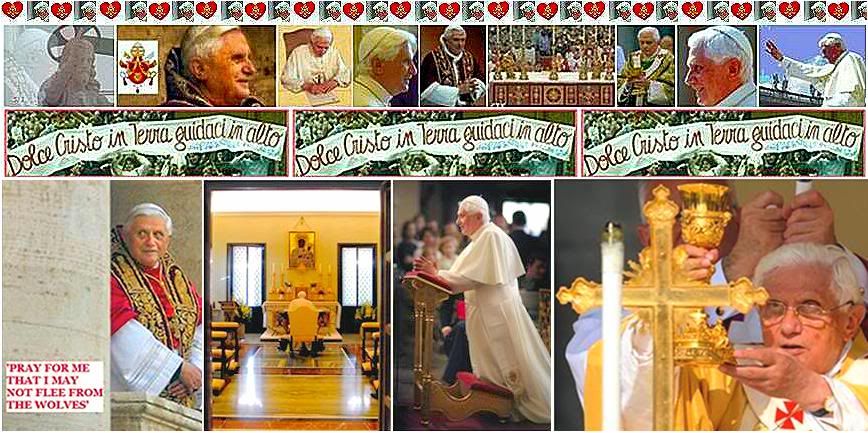
 See previous page for earlier posts today, 11/22/11.
See previous page for earlier posts today, 11/22/11.
 Tuesday, November 22, Final Week of the LiturgicalYear
Tuesday, November 22, Final Week of the LiturgicalYear
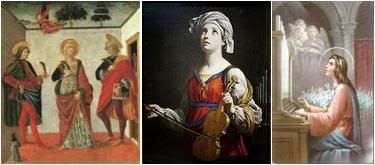 Left, Cecilia with Valerian and Tyburius; center, portrait by Guido Reni..
ST. CECILIA (Rome, 3rd century)
Left, Cecilia with Valerian and Tyburius; center, portrait by Guido Reni..
ST. CECILIA (Rome, 3rd century)
Virgin and Martyr, Patron of Music
For a saint who is so universally popular, little is known about this young Roman noblewoman.
The Golden Legend about her says she was married young to Valerian, whom she convinced
on their wedding night not only that they should be chaste but also to convert to Christianity.
He and his brother Tyburius converted, devoting themselves to burying Christian martyrs
and giving their goods to needy Christians. Eventually they were beheaded for refusing to
denounce the faith but not before converting Maximus, the guard assigned to them. The Roman
provost had him beheaded for this, and then sent for Cecilia, who refused to worship Jupiter
as ordered. He ordered her steamed to death in her bathroom, but when she was unharmed,
he had her beheaded. She survived the mandatory three-sword strikes but lived three more
days, during which she gave away all she had, and converted more people to Christ.
Her musical fame rests on a passing notice in her legend that she praised God, singing
to him, as she lay dying. Her incorrupt body was found long after her death. Devotion to her
started in the 6th century.
Readings for today's Mass:
www.usccb.org/bible/readings/112211.cfm
AT THE VATICAN TODAY
No events announced for the Holy Father today.
A news conference was held a the Vatican Press Room to present the XXVI International Conference organised
by the Pontifical Council for Ministry to Health Care Workers on the theme "pastoral health ministry in
the service of life, in the light of Blessed John Paul II's Magisterium" which will be held at the Vatican
On 11/24-26. It will be preceded by the first meeting of bishops in charge of pastoral health ministry to take place
tomorrow in the Vatican.
OR for 11/21-11/22:

At the end of his apostolic visit to Benin, the Pope entrusts to Africa
the task of being 'salt of the earth and light of the world':
'Land of hope'
Benedict XVI's closeness and encouragement to the poor, the sick, and all those neglected by society
This issue offers six pages of reportage and papal texts covering almost the entire apostolic visit to Benin, but contains only the two color photos shown above. The introductory story and editorial on Page 1 have been translated and posted on the preceding page. Other Page 1 news: Spain chooses change as it overwhelmingly votes out the Socialist government of Jose Luis Zapatero in favor of the conservative Popular Party; and a report on major disturbances in Egypt as protestors target the temporary military government to hasten the transfer to civilian power. The OR headline says 'Arab autumn' (Western media and politicians obviously went overboard in prematurely calling the changes that have taken place in the Arab world since last January an 'Arab spring' - despite all signs that what would follow the inevitable change in regimes brought about by largely bloodless revolutions would not necessarily be 'spring-like'.]
[Modificato da TERESA BENEDETTA 22/11/2011 18:09] |
| |
|
| |
 23/11/2011 04:49 23/11/2011 04:49 |
|
| | | OFFLINE | | Post: 23.825
Post: 6.396 | Registrato il: 28/08/2005
Registrato il: 20/01/2009 | Administratore | Utente Master | |
|
 I can't remember being so entranced by an event - a relatively minor one - during Benedict XVI's apostolic trips as the visit he had with children at St. Rita's parish in Cotonou. A ZENIT reporter provides additional details to the story in the OR (translated and posted in the preceding page). I have tried my best to find the newsphotos to illustrate the report, but the available photos do not always match the written report, but help set the scene fairly well... And I say again, there should be more occasions like this for the Pope to interact with kids; perhaps it can be a regulara feature of his trips....
In Benin, the Pope
I can't remember being so entranced by an event - a relatively minor one - during Benedict XVI's apostolic trips as the visit he had with children at St. Rita's parish in Cotonou. A ZENIT reporter provides additional details to the story in the OR (translated and posted in the preceding page). I have tried my best to find the newsphotos to illustrate the report, but the available photos do not always match the written report, but help set the scene fairly well... And I say again, there should be more occasions like this for the Pope to interact with kids; perhaps it can be a regulara feature of his trips....
In Benin, the Pope
honors the children
by Anne Kurian
Translated from the French service of

ROME, Nov. 20 (ZENIT.org) – "Let the little children come to me". Benedict XVI lived Christ's invitation when he met with the children in the care of Blessed Teresa's Missionaries of Charity in the suburban parish of St. Rita in Cotonou.
It was a meeting marked by simplicity and enthusiasm on both sides, and a 'first' in the history of papal visits.
First, he presided at the celebration prepared by the children in the courtyard of the Foyer Paix et Joie (Peace and Joy Children's Home) before going to the adjoining parish church to meet adult parishioners.
Arriving around 5:20 p.m., the papal motorcade threaded its way through a joyous throng waving yellow-and-white Vatican flaglets. And when the Pope stepped out of the car, he was greeted by drums beating out rhythms to the chanting of "Glory to the Risen One".
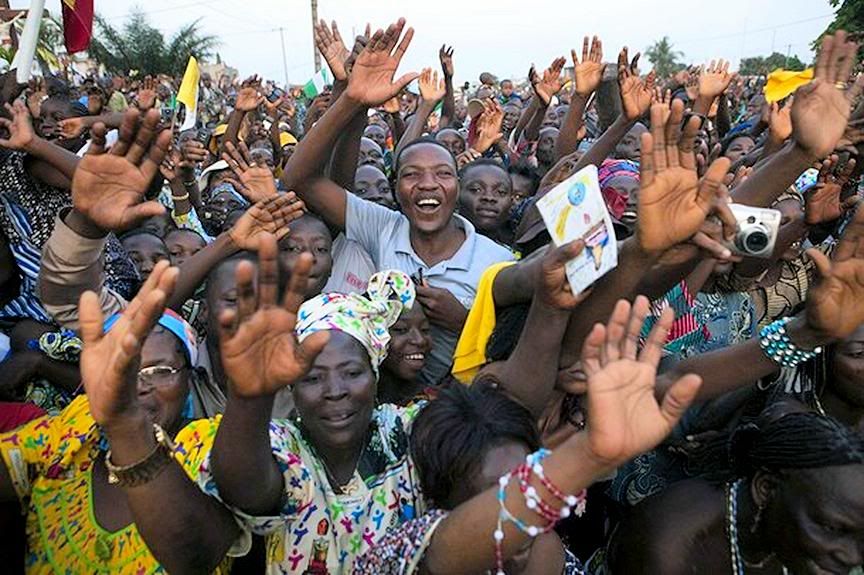
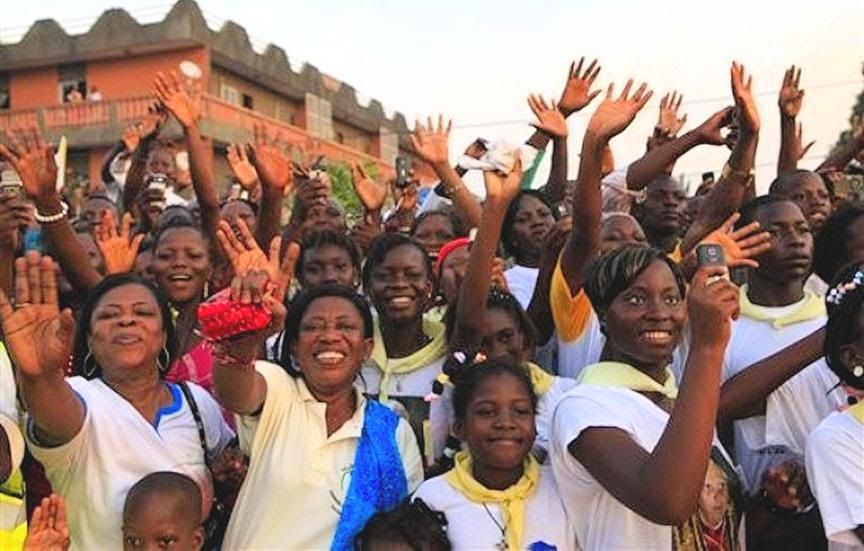
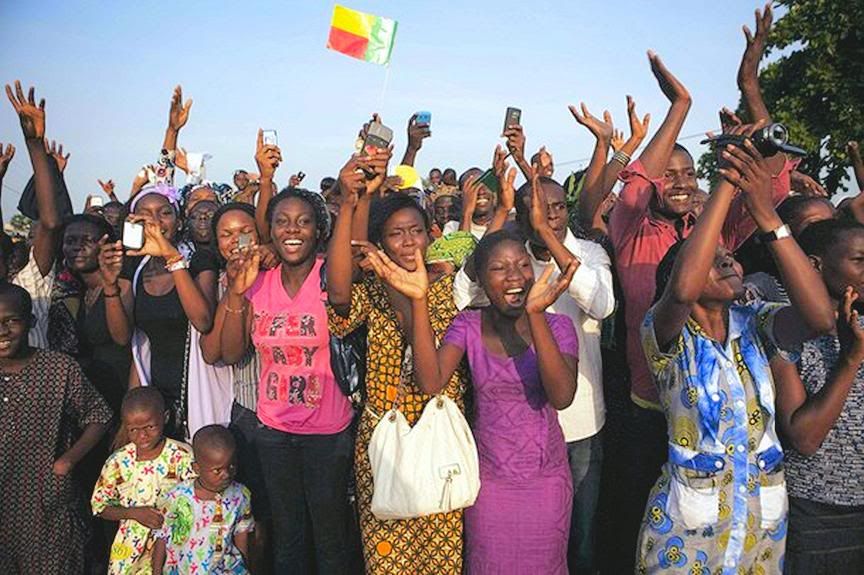
The entrance to the children's home was adorned with an archway of yellow-and-white balloons, through which the faithful then passed in order to greet the Pope. A nun in the distinctive garb of the Missionaries of Charity presented the Pope with a garland of flowers.
Then a group of children dressed in orange with matching head scarves emerged to surround the Pope as they sang and danced and led the Pope to the hall where the program was held.
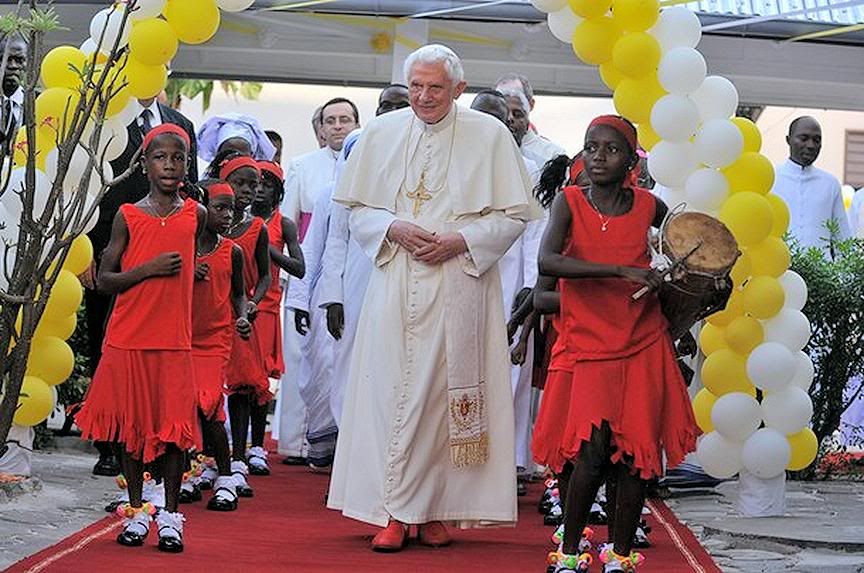
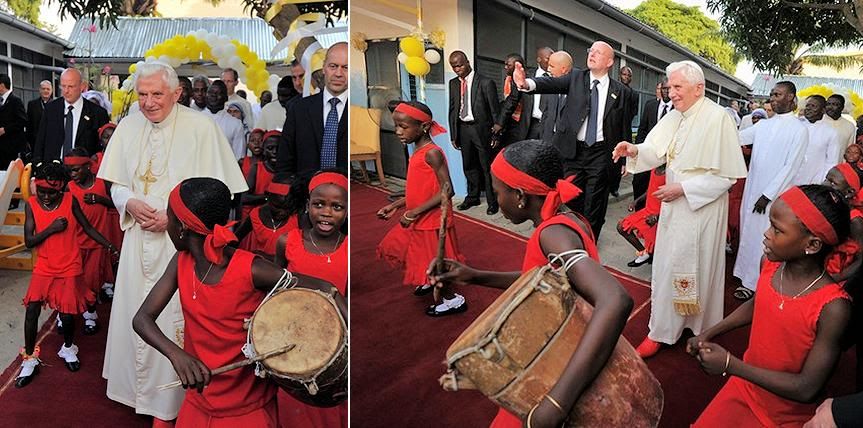

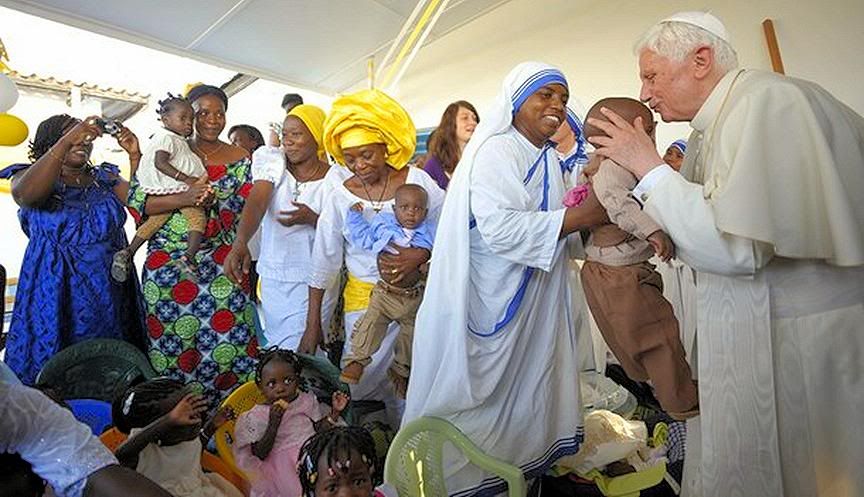
Other children gathered there, about 200, greeted the Pope with "Bienvenue chez nous, Pape!" (Welcome to our home, Pope) in full-throated cry. The Pope, obviously touched, applauded them, and even the security men with the Pope could not repress smiling tenderly at this demonstration.
And with natural simplicity, children, nuns, officials and the Pope moved about in close contact brought upon by the limited space available.
The slightest gesture was remarked. A two-week-old baby was presented to the Pope and he blessed her.
The heat and the toil from the long day he already had showed on the Pope's face. But this did not detract from his obvious joy at being with the children, whom he led first in reciting the 'Our Father' and at the end, the 'Hail Mary' before giving them all his apostolic blessing.
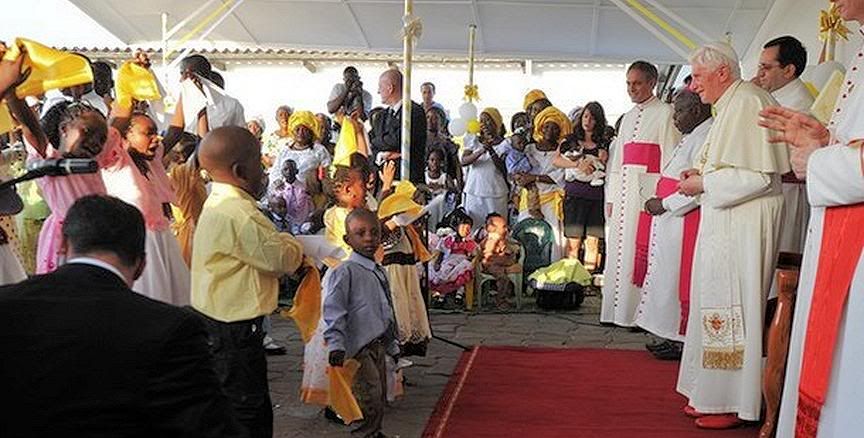

Then to a new burst of dancing and chants of the country's jubilee hymn, "Rejoice, cry out in joy!" - Benin is marking 150 years of its evangelization - the children and other parishioners once again surrounded the Pope to lead him to the nearby parish church.
Before entering the Church, the Pope paused to give a blessing to those outside the church, and then went up the central aisle which was decorated in white. After kneeling for a few moments in prayer, he walked up to the the choir area under a huge Crucifix.
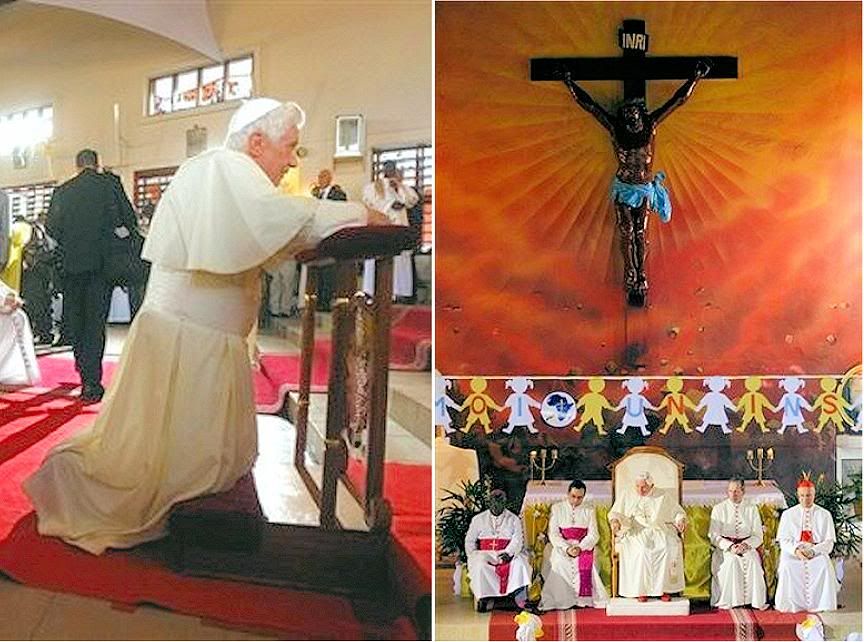
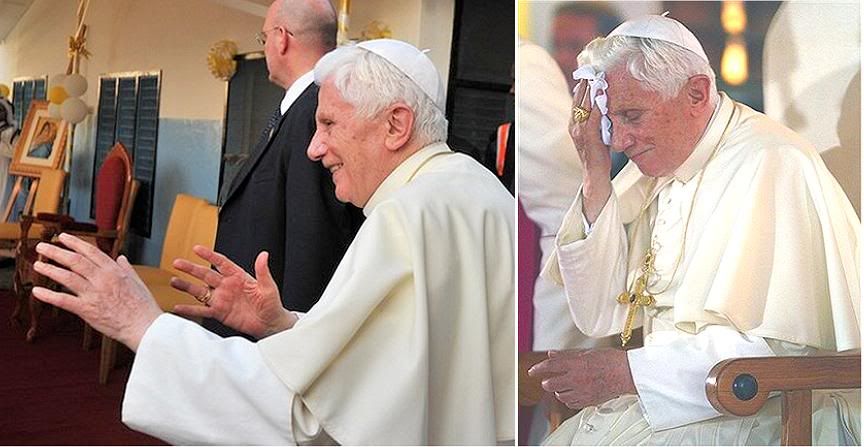
The 800-seat church teemed with children who tirelessly waved their flaglets and handkerchiefs, and leaned their faces every which way to keep the Pope in view.
Once the Pope took his seat, the euphoria reached a peak. Parishioners, clearly transported with joy, applauded as much as they could and chanted the slogan of the visit:
« Pape au Bénin ! Réconciliation !
Pape au Bénin ! Justice !
Pape au bénin ! Paix ! »
Mons. René-Marie Ehuzu, Bishop of Porto Novo, who was to deliver a greeting, had to wait several minutes until the assembly quieted down. But he had to ask for it. "Silence!" he said a few times, and then added, with a touch of humor: "I want to be able to hear a fly move!"
Then, speaking in the name of the children, he told the Pope quite simply: "We love you and we are very happy to be with you now".
He recalled to the assembly that "life itself is a fundamental value, and every child is a gift of God."
And he thanked the Pope for giving the children "a chance to meet you to offer them the love of Jesus", asking that the Church may continue her efforts in behalf of all children, and that the Holy Father may continue to be their spokesman to the governments otf the world.
After the bishop, 12-year-old Aisha, wearing a traditional blue headdress, addressed the Pope "in the name of all children".
"This is the first public audience you have held outside Rome for children of our age," she said, pronoucning every word clearly, "and we are very honored".
She thanked the Pope for the faith that he had come to reconfirm in Benin. "We are all ready to accept your message," she said.
"In return, we would have wanted to give you a gift to match our gratitude, but we can only give you our prayers". She said they ask God to give him the strength to carry our his ministry every day.
As Aicha spoke, two children walked up to present a gift: a gold-framed portrait of Benedict XVI with the official logo of the visit in the background (the map of Africa in the form of a dove, with a gold cross on the map).
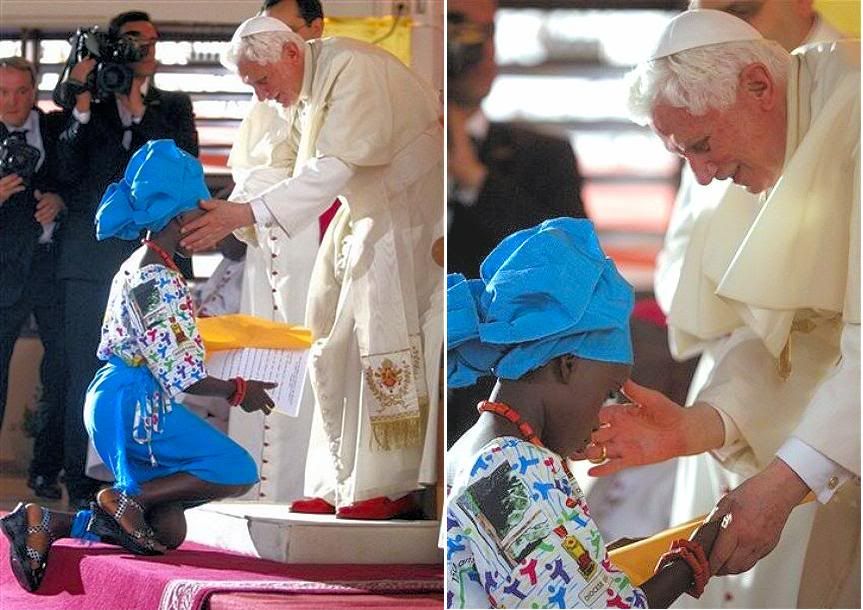
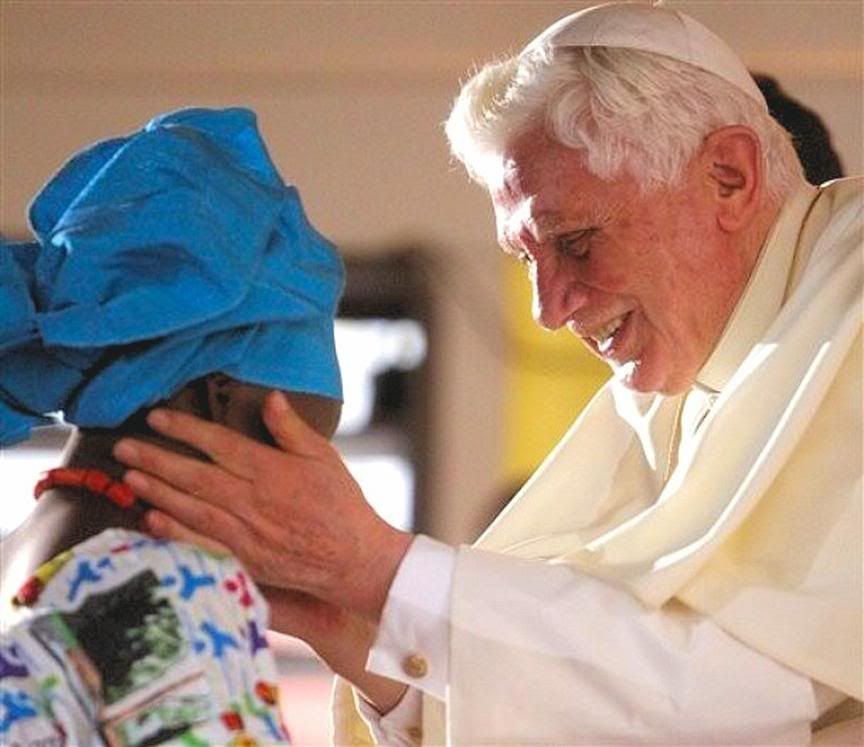
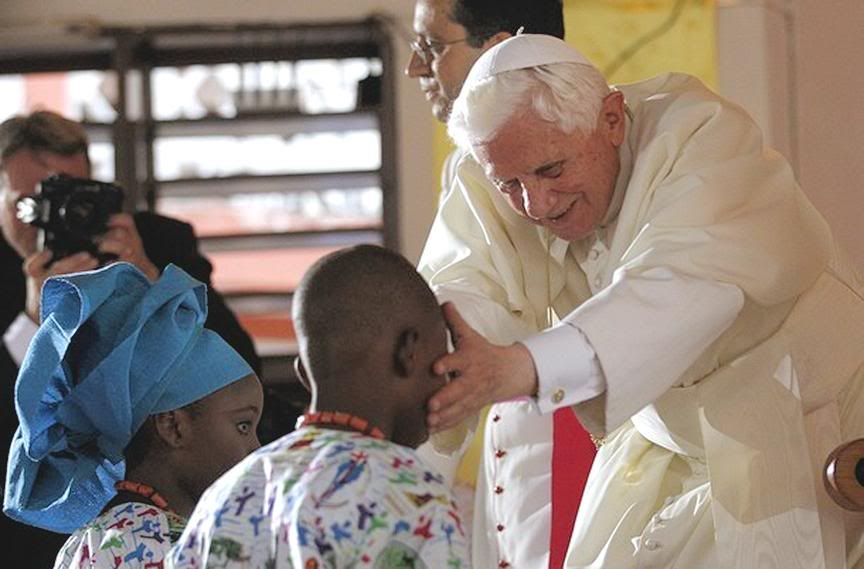
In response, the Pope gave the children a mini-catechesis on the love of Jesus and how to pray, and did not hesitate to take out a rosary from his pocket to invite the children to use the rosary as an 'instrument' for prayer and to encourage their parents to pray with them.
He ended his talk by leading them in a "Hail Mary" and then presented the church with a portrait of the Virgin with the Baby Jesus in the manger.
The Foyer Paix et Joie takes care of many dozens of children who are abandoned or gravely ill, some of them victims of AIDS. Six Missionaries of Charity help the parish in caring for them.
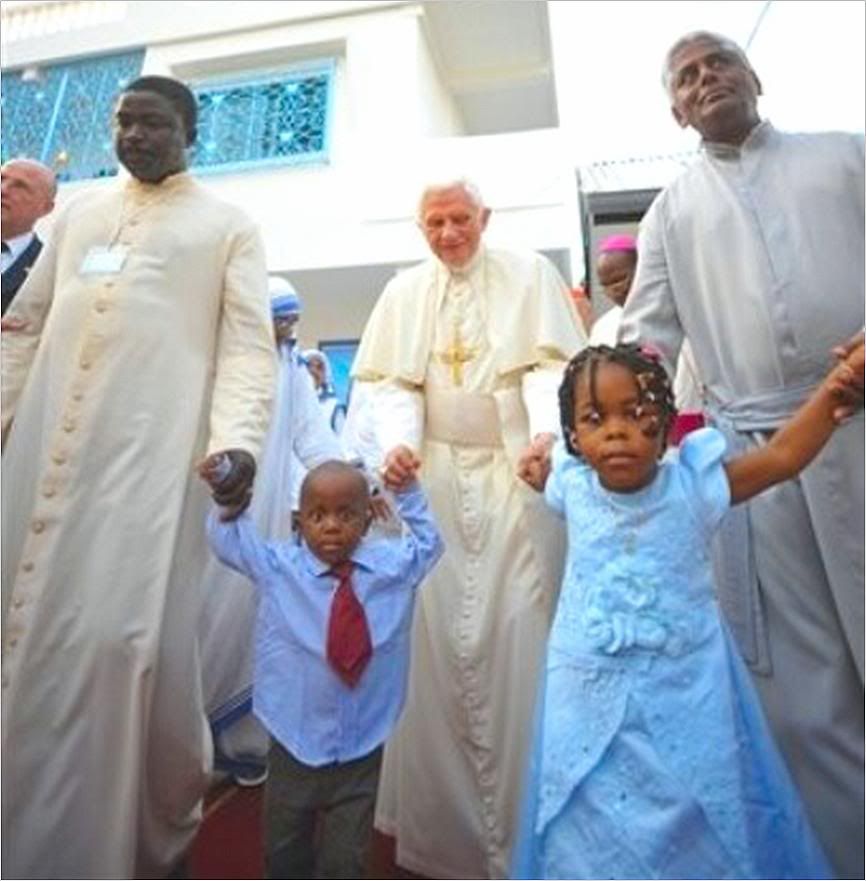 The photo below comes from the front page of the 11/23/11 issue of OR, so it does not enlarge very well, but this image is so endearing!
The photo below comes from the front page of the 11/23/11 issue of OR, so it does not enlarge very well, but this image is so endearing!
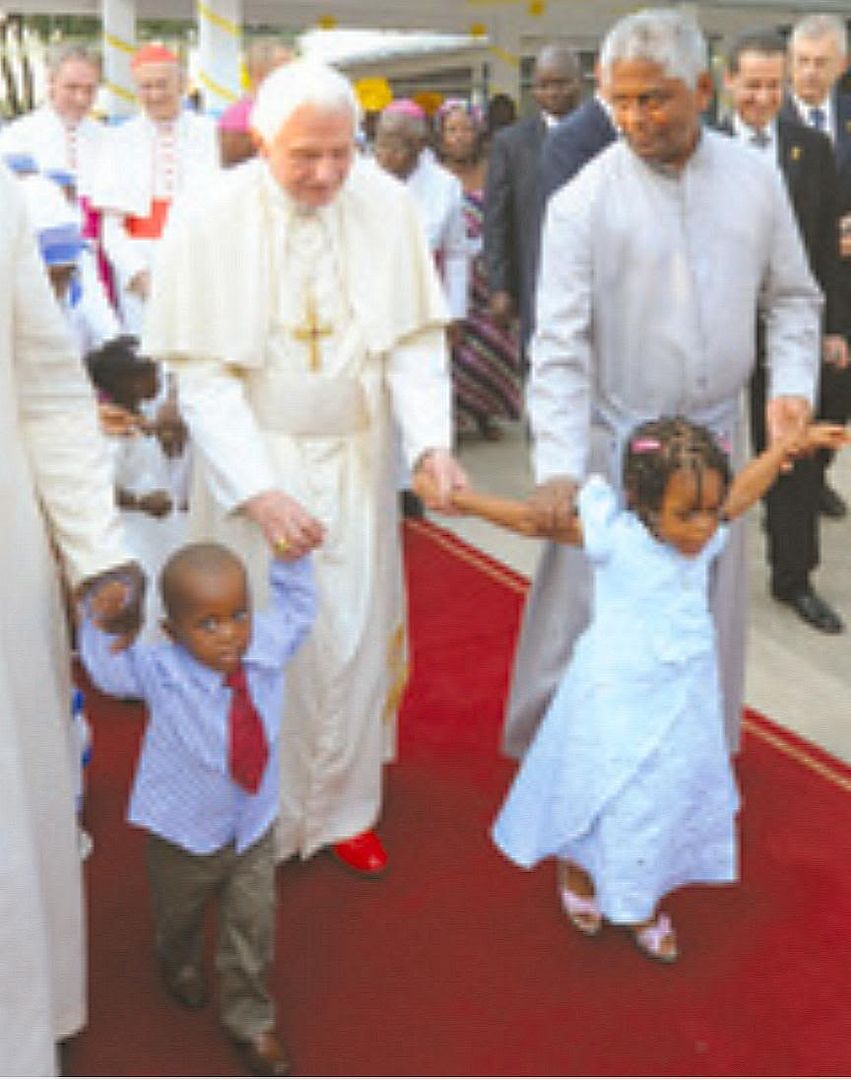
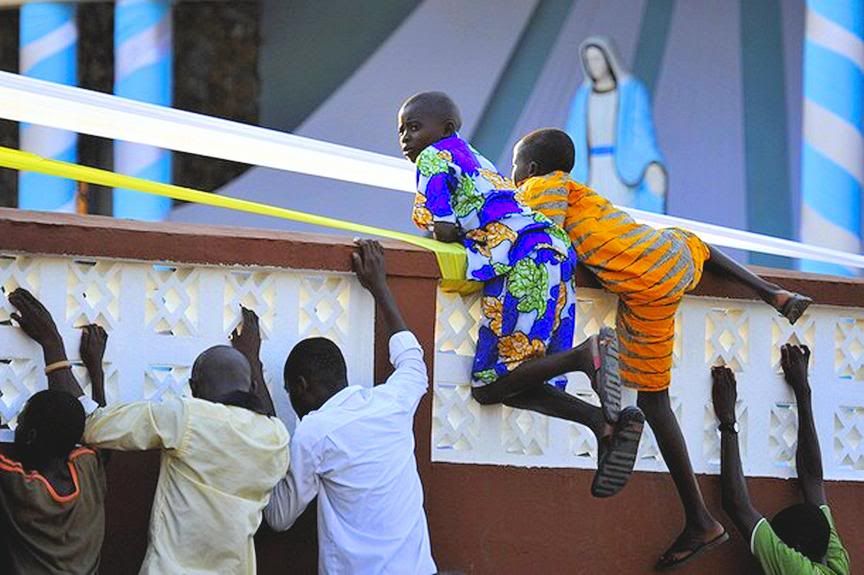
[Modificato da TERESA BENEDETTA 23/11/2011 08:44] |
| |
 23/11/2011 07:19 23/11/2011 07:19 |
|
| | | OFFLINE | | Post: 23.826
Post: 6.397 | Registrato il: 28/08/2005
Registrato il: 20/01/2009 | Administratore | Utente Master | |
|

 German bishops will divest holdings
German bishops will divest holdings
in publishing giant that deals in porn
By David Kerr

Berlin, Germany, Nov 22, 2011 (CNA) - The Catholic Church in Germany says it will act “without delay” to sell its stake in a publishing company that offers pornography among its products.
“We cannot earn money during the week with what we preach against on Sundays,” Cardinal Joachim Meisner told Germany’s Welt am Sonntag newspaper Nov. 22.
The Weltbild Publishing Group is one of Germany’s largest publishers, with an annual income of $2.2 billion dollars, nearly 6,500 staff and book stores on the main street of many German towns and cities.
However, it also publishes and distributes nearly 2,500 pornographic titles, largely through their Internet sites. [Besides its erotica and porn, it also sells books on other religions, as well as Satanism and other exotica.]
At present, 12 of Germany’s 27 dioceses own just over 24 percent of the shares in the publishing firm. Some dioceses have already divested themselves of their stock in recent years, including the Archdiocese of Cologne which is led by Cardinal Meisner.
Today’s announcement comes only weeks after Pope Benedict XVI criticized the German bishops for their investments.
“The time has come to take an energetic stance against prostitution and the widespread availability of erotic and pornographic material, also on the Internet,” he told the new German ambassador to the Holy See on Nov. 7.
“The Holy See will ensure that the Catholic Church in Germany takes clear and decisive initiatives against this form of abuse,” promised the Pope.
The news of the Church’s involvement in the pornography business broke just days before the Pope’s intervention. Initially, the German bishops issued a statement that said a “filtering system failure” at the publishing house had allowed the pornographic books to stray onto the market.
However, Berhard Müller, the editor of the German Catholic magazine PUR told the media Nov. 6 that a group of concerned Catholics sent 70-page document to the bishops in 2008 that he said contained evidence Weltbild was publishing pornography as well as books on Satanism and magic. They requested that such publications be stopped right away. “Believers have been complaining to their bishops about this for years,” said Müller.
In a Nov. 22 statement, Weltbild said it welcomed the decision of the bishops as it had been impossible to “adequately restrict the internet-supported dissemination and production of media that contradicted the ideals of the shareholders."
[For some reason, the original stories about this claimed the German dioceses and a nationwide diocesan lay association owned 100% of the shares. In any case, it's hard to imagine that it had to take an unusual public statement by the Pope - using an unlikely event as the launching pad - to get the bishops to do something about what is really a shameful situation. What were they thinking? Or were they thinking at all? They cannot plead ignorance because Weltbild's full range of offerings was online for anyone to see.]
|
| |
 23/11/2011 08:15 23/11/2011 08:15 |
|
| | | OFFLINE | | Post: 23.827
Post: 6.398 | Registrato il: 28/08/2005
Registrato il: 20/01/2009 | Administratore | Utente Master | |
|

 I find it strangely perverse of the MSM to keep reporting on the social doctrine of the Church as though it was always being stated for the first time. Perhaps because they find it unlikely for the Vatican to make any statements about the global economy and the world economic recession which has now lasted more than three years. Equally strange is that I have to use a report from the Irish Times, of all sources, for this report. [OR for 11/23 has an article about it, obviously, but it has to be translated, so let me take the easy way out first...[
Vatican again urges radical
I find it strangely perverse of the MSM to keep reporting on the social doctrine of the Church as though it was always being stated for the first time. Perhaps because they find it unlikely for the Vatican to make any statements about the global economy and the world economic recession which has now lasted more than three years. Equally strange is that I have to use a report from the Irish Times, of all sources, for this report. [OR for 11/23 has an article about it, obviously, but it has to be translated, so let me take the easy way out first...[
Vatican again urges radical
reform of global marketplace
by PADDY AGNEW in Rome

Nov. 23, 2011
ROME - For the second time in the last month, the Holy See has argued that international trade markets need to be radically reformed.
The point was made by Vatican Secretary of State Cardinal Tarcisio Bertone who, at a Vatican meeting of European Bishops’ Conferences [CCEE- from the Latin for Council of European Bishops' Conferences, celebrating its 40th anniversary this year] on the New Evangelisation yesterday: “The [global] crisis illustrates clearly the untenability of a market that has become totally self-referential . . .
“This present difficult situation prompts a whole series of new questions about the responsibilities and the ethics of the marketplace; it urgently asks a fundamental question about the destiny, dignity and spiritual vocation of man . . . ”
These comments from Pope Benedict XVI’s closest adviser come less than a month after the Holy See’s Pontifical Council for Justice and Peace presented a document which called for the establishment of a world economic authority to best handle the current global crisis.
Entitled "Towards Reforming the International Financial and Monetary Systems in the Context of Global Public Authority", that document argued that during a period of huge economic growth, from 1900 to 2000, “economic liberalism” had found it hard “to apply and consolidate . . . controls and rules” with regard to market functioning.
The document concluded by calling for a radical reform of the international monetary system, such as the creation of “some form of global monetary management” or “central world bank”.
The cardinal’s observations placed the global crisis in the context of a changing world which was seen “a critical, at times dramatic evolution of the religious experience”, as traditional Christian teachings, especially on sexual mores, have come ever more into “open conflict” with an intolerant lay tradition.
Though, just as strangely, neither CNA nor CNS reported on the CCEE conference and Cardinal Bertone's speech yesterday (11/22) - nor, to be fair, and more strangely, neither did the English service of Vatican Radio - John Thavis opportunely, using the Africa trip as a newspeg, did a yeoman's job for CNS in compiling many of Benedict XVI's statements on the world's economic and financial system and its ills, making the much-needed point that, long before the crisis began in 2008, this Pope has always been vocal about his critique of a system that penalizes the poorer nations as the richer nations push their globalization initiatives:
Pope's critique of global economic system
resurfaces in Africa
By John Thavis

VATICAN CITY, Nov. 22 (CNS) -- A few minutes after landing in Africa, Pope Benedict XVI delivered a stern warning against the "unconditional surrender to the law of the market or that of finance" in Africa and throughout the global economic system.
His words were immediately seized upon by those wondering where the German Pope stood on a recent Vatican document that proposed the creation of a world political authority to regulate financial markets and rein in the "inequalities and distortions of capitalist development."
In short, it seemed the Pope was speaking the same language as the document's authors. ['It seemed'??? of course, it was the same language - only he did not go into the technical specifics that the PCP did, because Popes don't do that! Actually, Thavis overplays this angle, because it's not as if any major news agency reported this part of the Pope's many statements on his first day in Benin!]
In his own document unveiled during the Nov. 18-20 trip to Benin, the Pope asked all members of the Church to "work and speak out in favor of an economy that cares for the poor and is resolutely opposed to an unjust order which, under the pretext of reducing poverty, has often helped to aggravate it."
He specifically denounced business groups that exploit African resources and leave local populations impoverished.
All of this seemed to echo the tone of the 41-page text on global financial reform released in late October by the Pontifical Council for Justice and Peace.
Such admonitions, however, are nothing new for Pope Benedict. Those who have paid attention in recent years know that the Pope has consistently taken a wary and critical view of the global economic system and the disparities it has generated. [There, Thavis finally came to the point. Of course, none of this is new at all, and as I have had occasion to say earlier in connection with the PCJP document, all Popes since Leo XII have decried the inherent evils of economic liberalism. However, Benedict XVI has perhaps been more persistent in his critiques than his predecessors - he really has not wasted any occasion to do so.]
Above all, he has taken aim at the patterns of consumption that seem to be built into the structures of modern capitalism. He has done so repeatedly, in language that leaves no doubt about where he stands.
In 2007, for example, he deplored materialistic ideologies that tell people: "Take everything we can get in this brief moment of life. Consumerism, selfishness and entertainment alone are worthwhile. This is life. This is how we must live. And once again, it seems absurd, impossible, to oppose this dominant mindset with all its media and propagandist power."
The same year, addressing Catholic economic experts, the Pope said economic models based on "irresponsible consumption of natural and environmental resources" were jeopardizing the well-being of present and future generations.
He has warned that "the consumer race and consequent waste" not only threaten supplies of resources but also tend to generate a spiritual vacuum among people in well-off countries. He views consumerism as an ideology, and he said in 2010 that the prevailing models of consumption and production are clearly unsustainable.
Visiting Brazil in 2007, the Pope critiqued the false promises of Marxism and capitalism. Marxism, he said, has left a sad heritage of economic and spiritual destruction. He added: "And we can also see the same thing happening in the West, where the distance between rich and poor is growing constantly, and giving rise to a worrying degradation of personal dignity through drugs, alcohol and deceptive illusions of happiness."
Visiting a homeless shelter in 2010, the Pope described the global economic system as a world in which "the logic of profit and the search for self-interest seems to prevail." That was a key point in his 2009 encyclical, Caritas in Veritate, which said financial speculation for "short-term profit" was a cause of global financial insecurity.
Last July, the Pope said world hunger was also a consequence of the current economic model: "How can we be silent about the fact that even food has become the object of speculation or is tied to the course of a financial market that, lacking definite rules and poor in moral principles, appears anchored to the sole objective of profit?"
The document by the justice and peace council was more specific than papal pronouncements in proposing concrete measures to correct economic imbalances, and that's where it drew the most criticism.
In particular, its call for a "central world bank" to regulate monetary exchanges was seen by some as violating the Church's teaching about subsidiarity -- the principle that a central authority should perform only those tasks which cannot be performed effectively at a more local level.
Writing about economic and social justice in his document on Africa, Pope Benedict reiterated that principle and cited the Compendium of the Social Doctrine of the Church: "In accordance with the principle of subsidiarity, neither the state nor any larger society should substitute itself for the initiative and responsibility of individuals and intermediary bodies."
But Pope Benedict also has expressed his view that current modes of regulating the financial system have failed, and that new structures and institutions may be needed.
Addressing the Pontifical Academy of Social Science in 2010, the Pope strongly argued that the market is not a self-calibrating mechanism and that oversight may have to take new forms.
"The worldwide financial breakdown has, as we know, demonstrated the fragility of the present economic system and the institutions linked to it. It has also shown the error of the assumption that the market is capable of regulating itself, apart from public intervention and the support of internalized moral standards," he said.
The current crisis, he added, "obliges us to re-plan our journey, to set ourselves new rules and to discover new forms of commitment."
Pope Benedict's language on economics is very much in keeping with Blessed John Paul II, who warned of an "idolatry of the market" and said there was a "social mortgage" on private property, which must serve the common good.
[Modificato da TERESA BENEDETTA 23/11/2011 08:27] |
| |
 23/11/2011 15:54 23/11/2011 15:54 |
|
| | | OFFLINE | | Post: 23.828
Post: 6.399 | Registrato il: 28/08/2005
Registrato il: 20/01/2009 | Administratore | Utente Master | |
|
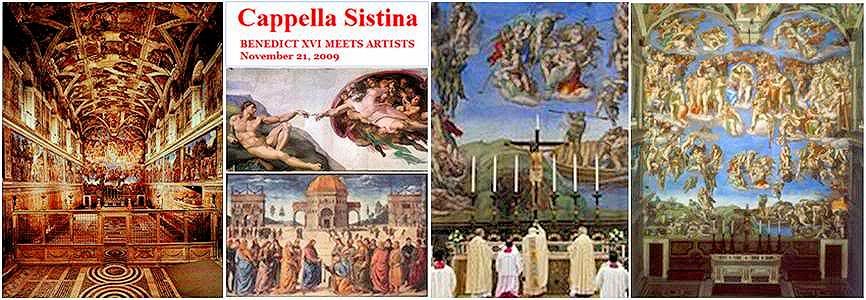 Another significant anniversary observed this week was the two years since Benedict XVI met with artists from many nations and many faiths (or no faith) at the Sistine Chapel on November 21, 2009. This essay by a professor from the Pontifical University of Santa Croce looks back...
Benedict XI and artists:
Another significant anniversary observed this week was the two years since Benedict XVI met with artists from many nations and many faiths (or no faith) at the Sistine Chapel on November 21, 2009. This essay by a professor from the Pontifical University of Santa Croce looks back...
Benedict XI and artists:
The lesson of Michelangelo
by Ralf vanBuehren
Translated from the 11/21-11/22/11 issue of

From the start of the 20th century, the relationship between the Church and contemporary art has been, in many aspects, tense as well as detached. In 1975, Pope Paul VI observed correctly that "the rupture between the Gospel and culture is undoubtedly the tragedy of our time".
The reasons for this problematic relationship are complex, and the impression is that they come from both sides. Today, there are still many Catholics who lack - as do most of their contemporaries - an understanding and true interest in the aesthetic intentions of contemporary art that generally presents itself as radical.
On the other hand, with the progressive secularization of society and culture, many avant-garde artists do not have a basic Christian formation, and all too often, no personal disposition, either, to deal with Biblical and theological themes.
During the first half of the 20th century, the Church increasingly faced critical attiudes towards religion and to the Church herself, from artists whose lives were a contradiction to the Christian faith. Such negativism - the lack of some universal sense of how artists represent man and the world - was incompatible with the Church’s positive vision of man, pervaded by hope.
Modern art at the start of the 20th century represented an esthetic and spiritual challenge to which the Church Magisterium from Pius XII to John Paul II reacted prudently.
Paul VI, ‘the Pope of dialog’, loved the arts, especially contemporary art. “The Church needs saints, we know,” he said in 1967, “but she also needs artists who are brilliant and able. Both – saints and artists – are witnesses to the living spirit of Christ”.
In 1964, he invited artists to a Mass at the Sistien Chapel. In his homily, he underscored the bond between art and religion, and offered the artists an alliance based on friendship. This offer opened a pastoral change in the modern dialog between art and the Church. Particularly decisive was the Pope’s invitation to pass beyond the situation of Church and art ‘alongside each other’ (or even of Church and art 'against each other’) to ‘working with each other’.
Paul VI’s words stirred great enthusiasm among many artists. Some of them as well as important art patrons spontaneously sent the Pope works of art that became the nucleus for the collection of modern religious art in the Vatican Museums.
Inaugurated in 1973, the collection shows the interest of the Church in ‘autonomous’ contemporary religious art – namely, religious art that is produced spontaneously, not motivated by a commission to create an art work for a sacred space.
Today, the collection includes some 800 works by 250 artists from around the world. It documents evocatively the subjective way in which these artists individually approached and expressed the Christian message and their religious sentiments.
Unfortunately, the hope that Paul VI expressed in many ways for a ‘new springrtime of post-conciliar religious art’ was never realized.
John Paul II continued the ‘reform’ of his predecessor. In his first encyclical, Redemptor hominis (1979), he appealed to the responsibility that artists have towards the truth. In order to promote at the level of the universal Church a 'dialog of equals' between Church and culture, he established the Pontifical Council for Culture in 1982, in the belief that “the synthesis of culture and faith is not just an exigency of culture but also of faith”.
.
Between 1980 and 1986, he made various similarly programmatic statements to artists in Munich, Vienna, Brussels and Rome. He advocated a dialog between artists and the Church in a spirit of collaboration and responsibility, and made numerous references to the nature, purpose and mission of art – especially Christian art - as well as the analogy between art and faith.
In 1999, John Paul II published a Letter to Artists, in which he invited them to a dialog and cooperation with the Church, underscored the close synthesis possible between art and faith, and indicated Sacred Scripture as a principal source of inspiration for Christian art.
With that letter, the Pope summarized the teachings on art that he had formulated over the past 20 years, and prepared for the Jubilee with artists in 2000 in Rome, when he delivered a message on the analogy between art and holiness.
In the Mass celebrated by Paul VI at the Sistine Chapel in 1964, those present were almost exclusively Italian. In 2009, Benedict XVI broadened the circle of invitees. There were Catholics and Christians from other confessions, followers of non-Christian religions, agnostics and atheists, from many nations. For this reason, Benedict’s address was not limited to ‘Christian art’.
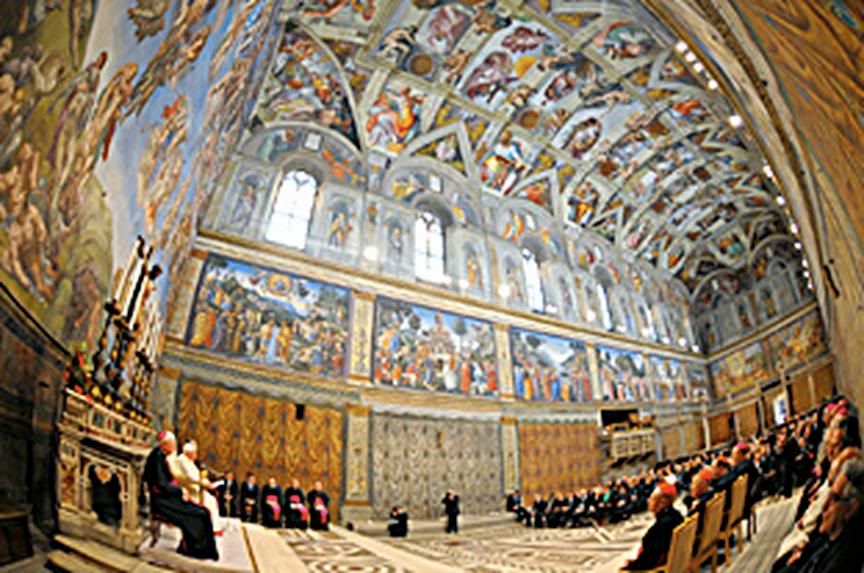
The nature of Benedict XVI’s meeting with artists on November 21, 2009, corresponded to the master lines of his Pontificate. As he announced in his first homily as Pope on April 20, 2005, he wishes to provide an impetus for inter-religious and inter-cultural dialog.
This is the context for the Church's relationship with artists who must "take into account social-cultural conditions and changes", as he said in his address to the artists he invited to the Sistine Chapel on November 21, 2009.
The central point of that discourse was the harmony betweene art and faith, between esthetics and ethics. Thus Benedict XVI returned to the central aspects of pontifical ministry to artists that followed the Second Vatican Coun-cil. [One has the impression that this was an intention that was never really actualized.]
Christianity "since its beginnings, has always understood the value of the arts and has wisely used artistic expressions when confronted with the great questions of existence, with the fundamental themes that give meaning to life and that can assume a religious valency and be transformed through profound interior reflection and spirituality".
The rest of the discourse seemed like a theological commentary on the fresco of Michelangelo’s Last Judgment in the Sistine Chapel.
The Pope interpreted its ‘dramatic beasuty’ as ‘an announcement of hope, a powerful invitation to raise our eyes towards the final horizon”.
There is a profound link between beauty and hope, he said, amd cited the Message to Artists which was read in 1965 at the end of the Second Vatican Council and in its name: “The world in which we live needs beauty in order not to drown in desperation. Beauty, like truth, instills joy in the heart of man. Remember that you are the guardians of beauty in the world”.
Citing from great thinkers and artists, the Pope‘s discourse was a hymn to beauty inspired by Platonian-Augustinian metaphysics and by Sacred Scripture. Plato said that beauty produces a healthy jolt to man that makes him emerge from himself, opens the eyes of the heart and the spirit, and uplifts him.
The Pope distinguished between illusory beauty and authentic beauty which “opens the human heart to mostalgia, to the profound desire to know, love and proceed towards Otherness, beyond onself”. He praised the via pulchritudinis, the beauty of nature and art as a “way towards the Transcendent, towards the ultimate mystery, towards God”. A theme he first discussed in the General Audience of November 18, 2009, on “the encounter between aesthetics and faith” and the ‘harmony of faith and art’.
In this regard, Benedict XVI cited Herman Hesse: "Art means to show God within everything", and Simone Weil: "In everything that inspires in us a pure and authentic sentiment of beauty, God is truly present. There is almost a kind of incarnation of God in the world, of which beauty is the sign. Beauty is the experimental proof that incarnation is possible. And that is why, every work of art of the first order is, in essence, religious".
However, "in the modern world of interests", beauty is no longer 'loved' nor cherished “not even by religions", the Pope noted citing the 'esthetic theology' of Hans Urs von Balthasar.
With this observation, Benedict XVI also indicated Sacred Scripture as a fount of inspiration for art. Proof of the affinity between 'the course of faith and the artistic itinerary’ is "the incalculable number of art works that have the personages, the histories and the symbols of the Bible as protagonists".
Picking up from John Paul II's letter to the artists, Benedict XVI asked, "Does art need the Church?" and in asking this, he invited the artists to find "in the religious experience, in the Christian revelation, and in the great codex that is the Bible, a spring of renewed and motivated inspiration".
The Pope concluded his address with an appeal to the responsibility of artists. As "guardians of beauty", they are responsible for communicating it. Especially in times of crisis, when they can instill courage and hope.
"Thanks to your talents, it is possible to speak to the heart of mankind, to inspire dreams and hopes, to amplify the ho-rizons of knowledge and human commitment. Therefore be grateful for the gifts you have received and be fully aware of your great responsibility to communicate beauty, to communicate in beauty and through beauty.".
Benedict VXI then exhorted artists not to be afraid to "confront the first and last source of beauty, and to dialog with believers". Citing St. Augustine, in what was almost an expected comment on the Last Judgment, and referring in fact to Michelangelo's great fresco, he spoke of man's ultimate destiny:
"Faith takes nothing from your genius, your art - indeed, it exalts and nourishes, it encourages going beyond the threshold to contemplate with fascination and emotion the ultimate and definitive goal - the never-setting sun which illuminates the present and makes it beautiful".
In the Sistine Chapel, a testimonial to to great art and profound faith, these words of reconciliation were persuasive. "The setting was magnificent", said the German film director Philip Groening. "It was a symbol of the millenary dialog between art and the Church, and of the original conjunction of art and religion. It was a great gesture to invite everyone there to say, 'The Church needs artists who search for the transcendent'."
[Modificato da TERESA BENEDETTA 24/11/2011 05:55] |
| |
 23/11/2011 15:55 23/11/2011 15:55 |
|
| | | OFFLINE | | Post: 23.829
Post: 6.400 | Registrato il: 28/08/2005
Registrato il: 20/01/2009 | Administratore | Utente Master | |
|
 Wednesday, Nov. 23, 34th Week in Ordinary Time
Wednesday, Nov. 23, 34th Week in Ordinary Time
 ST. COLUMBAN (b Ireland 540, d Italy 615)
ST. COLUMBAN (b Ireland 540, d Italy 615)
Missionary, Abbot, Writer, 'Apostle of the Picts'
Considered the greatest of the Irish missionaries, he suffered temptations of the flesh as a youth and decided to become a hermit then a monk after seeking the advice of a nun. With 12 companions, he set forth for Gaul in 590 to spread the Gospel. He set up many monasteries, championed Catholic orthodoxy against heresies like Arianism, professed fierce loyalty to the Pope and wrote a monastic rule. Ordered into exile back to Ireland by the Queen Mother whom he displeased by his moral strictures, he was shipwrecked and landed back in Europe, proceeding to Italy where he befriended the King of the Lombards. He set up the famous monastery of Bobbio where he would
eventually die. He left behind many writings, including poetry, treatises and his famous Rule.
Also remembered today is a contemporary figure:
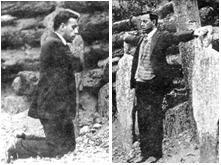
BLESSED MIGUEL AGUSTIN PRO (Mexico, 1891-1927)
Jesuit and Martyr
This priest was executed by firing squad on a charge that he plotted with his brothers
to assassinate the President of Mexico. His last request was to be allowed to kneel
in prayer before he was shot (see pictures). Growing to adulthood at the height of anti-
Catholic persecution in Mexico (the 1917 Constitution outlawed the Church and imposed
severe penalties against practising the religion), Father Pro spent many years in Belgium
where he worked with coal miners before returning to Mexico in 1926, actively working in
the underground Church. Before he was shot, he cried out 'Viva Cristo Rey!' (Long live
Christ the King!). He was beatified by John Paul II in 1988.
Readings for today's Mass:
www.usccb.org/bible/readings/112311.cfm
\
AT THE VATICAN TODAY
General Audience - The Holy Father reports on his apostolic visit to Benin, saying Africa represents a reservoir
of life and vitality that the Church can count upon for the future.
Pope to visit a Roman jail Dec. 18
and will answer prisoners' questions
The Pontifical Household made the following announcment today:
On December 18, Pope Benedict XVI will visit the Roman prison of Rebibbia. At 10 a.m., in the prison church dedicated to Our Father, the Pope will meet with the inmates to answer their questions.
Before leaving the jail at 11:30 to return to the Vatican for the Sunday Angelus, the Pope will bless a tree planted to commemorated the visit.
Other papal events for December were confirmed by Fr. Federico Lombardi, as follows:
December 8 - The traditional papal homage to Our lady of the Immaculate Conception in Rome's Piazza Spagna
December 11 - Pastoral visit to the Roman parish of Santa Maria delle Grazie in Casal Boccone
December 12 - Mass at St. Peter's Basilica on the feast day of Our Lady of Guadalupe
December 15 - Vespers with university students at St. Peter's Basilica
December 22 - The Pope's annual address to the Roman Curia
December 24 - Christmas Mass to start at 10 p.m.
December 31 - Vespers and Te Deum at St. Peter's Basilica
in thanksgiving for the year.
One year ago today...


Benedict XVI's book-length interview with Peter Seewald, LIGHT OF THE WORLD, was presented and formally launched
at the Vatican, in an event that had been overshadowed days before the launch by a false controversy over what
the Pope said about condom use. The controversy resulted from a careless translation published earlier by the
Vatican newspaper itself of statements he made about the hypothetical use of condoms by an HIV-infected prostitute,
leading the secular media to report falsely that Benedict XVI had changed Catholic teaching about condom use.
[BTW, I do not recall that the OR in any way apologized on its pages nor made a correction of its misleading translation (apparently taken from the Italian
translation of the book, which had to add correction inserts to books already in stores, and hastened to make the correction (and many others) in the
book's second printing. The lack of professionalism was quite appalling. if they could be so sloppy about a book by the Pope, how careful can they
be with 'lesser' figures?]
[Modificato da TERESA BENEDETTA 25/11/2012 06:12] |
| |
 23/11/2011 20:13 23/11/2011 20:13 |
|
| | | OFFLINE | | Post: 23.830
Post: 6.401 | Registrato il: 28/08/2005
Registrato il: 20/01/2009 | Administratore | Utente Master | |
|
 This time last year, almost all of Benedict XVI's projected pastoral and apostolic visits in Italy and abroad for the following year had been officially announced (the trip to Benin was formally announced on 11/26/10). In Italy, only Arezzo so far has been speculated...Angela Ambrogetti shows enterprise in drawing up this list...
The Pope's probable foreign trips in 2012:
This time last year, almost all of Benedict XVI's projected pastoral and apostolic visits in Italy and abroad for the following year had been officially announced (the trip to Benin was formally announced on 11/26/10). In Italy, only Arezzo so far has been speculated...Angela Ambrogetti shows enterprise in drawing up this list...
The Pope's probable foreign trips in 2012:
Msxico and Cuba, Lebanon and the Ukraine
by Angela Ambrogetti
Translated from

Nov. 22, 2011
Altnough nothing has been announced officially, Benedict XVI's program of apostolic visits abroad in 2012 appears to have taken shape. And it will be to Mexico and Cuba, as previously speculated, to Lebanon, and to the Ukraine.
Mexican media, citing the Ambassador of Mexico to the Holy See as its source, says the Pope will probably be visiting just one of the Mexican states, Guanajuato, probably on March 23-25.
He would be visiting the municipalities of Leon, Silao and the state capital Guanajuato. Its central event would be his pilgrimage to the Cristo Rey (Christ the King) in the Cubilete mountain range. It is a giant statue linked to the history of Maxican Catholicism for over a century, and a site which receives hundreds of thousands of pilgrims every year.
Other main events would be a Mass to celebrate the 200th anniversary of independence from Spain being observed by many latin American countries, and of course, a meeting with the bishops of Mexico.
A second trip would be to Lebanon, -pre-announced; in the local media, particularly the newspaper al-Safir, citing sources from the local Maronite Church, according to whom arrangements are being made between the Vatican and the Maronite Patriarch for such a visit.
The sources say the Pope's visit would be in line with a Vatican strategy to underscore its concern for the protection of Christians in Lebanon and the entire Middle East and North African region amid growing political turbulence.
The official invitation is expected to be extended when Lebanon's Prime Minister Najob Mikati meets the Pope at the Vaticana on Monday. Nov. 28.
The third foreign trip would be to the Ukraine, possibly in the autumn of 2012. This year, the Christmas trees for St. Peter's Square, the Pope's apartments, adn the Roman Curia are a donation from the Ukraine.
All the different Catholic Churches in the Ukraine are inf ull communion with Rome and with each other, although their histories as well as theological and liturgical traditions are significantly diverse. The Ukrainian Catholic Churches are considered sui iuris (having their own rules), and have different diocesan or eparchial structures, canonical laws, liturgical rites and cultural-historical idiosyncracies.
The Pope's host in the Ukraine would be Mons. Mieczysław Mokrzycki, familiar to Vatican followers as 'don Mietek',who had been a secretary to John Paul II and stayed on as the second private secretary of Benedict XVI until the latter named him, first, coadjutor Archbishop, then Archbishop himself of the Diocese called Lviv of the Ukraine, which is contiguous to Poland.
[Modificato da TERESA BENEDETTA 24/11/2011 00:47] |
| |
 23/11/2011 21:31 23/11/2011 21:31 |
|
| | | OFFLINE | | Post: 23.831
Post: 6.402 | Registrato il: 28/08/2005
Registrato il: 20/01/2009 | Administratore | Utente Master | |
|
 GENERAL AUDIENCE TODAY
GENERAL AUDIENCE TODAY
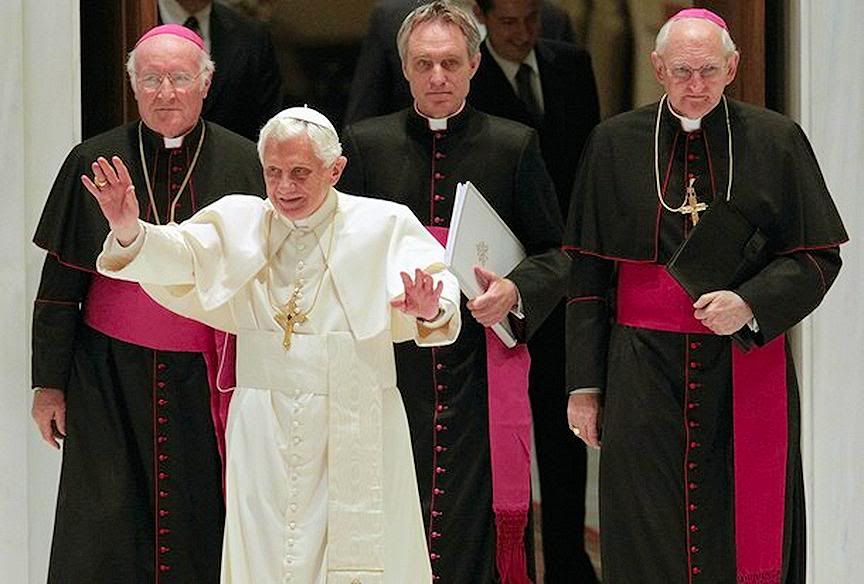
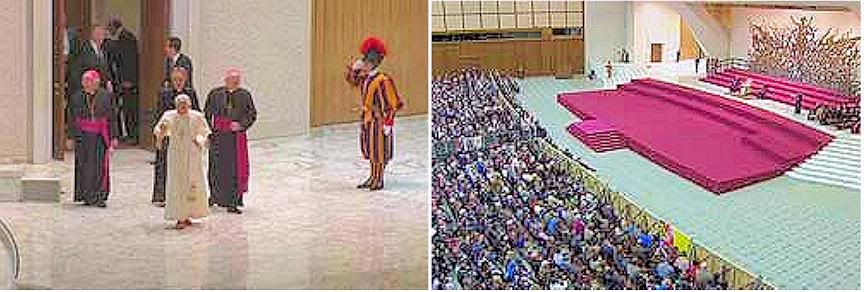 The Pope reports on
The Pope reports on
his trip to Benin

Nov. 23, 2011
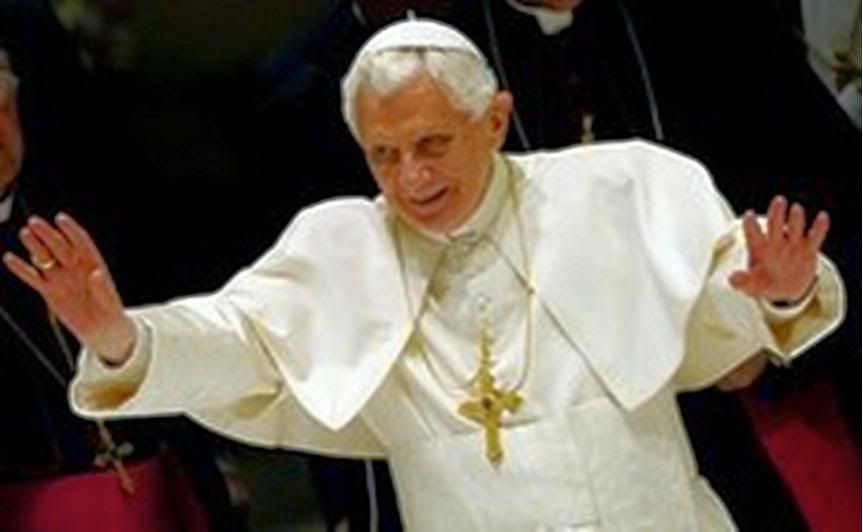
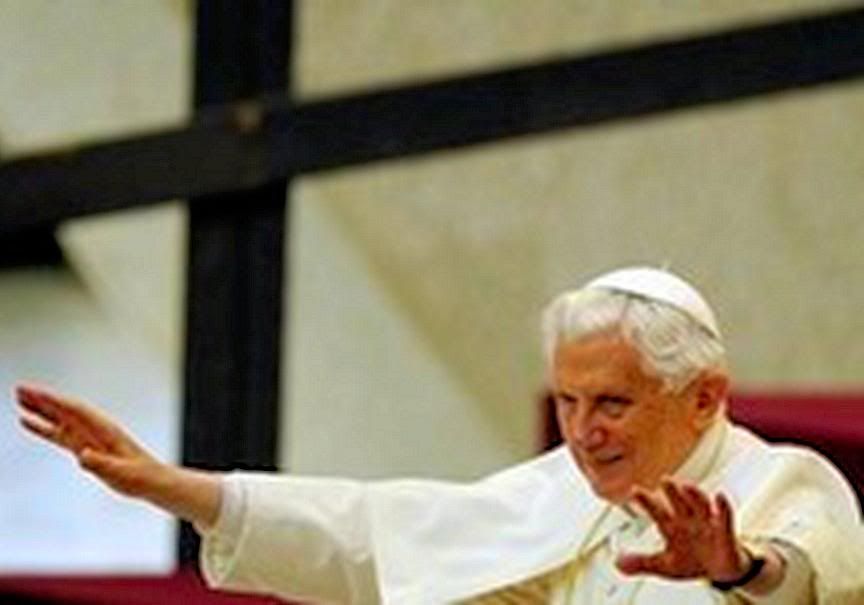

“I ask you to join me in commending all Christ’s followers in Africa to the maternal intercession of Our Lady of Africa, so that by their witness of fidelity to God’s word, their commitment to the spread of the Gospel and their efforts to build communion, peace and solidarity they can become protagonists of a new season of hope for that great Continent”, this was Pope Benedict XVI’s appeal Wednesday during his weekly general audience.
By tradition, the Holy Father dedicated his first major public appointment since his return from Benin, West Africa, on Sunday, to a report oon the visit, which he handed his guidelines for the future of the Church there, the post-Synodal Exhortation Africae Munus, to the people of the continent.
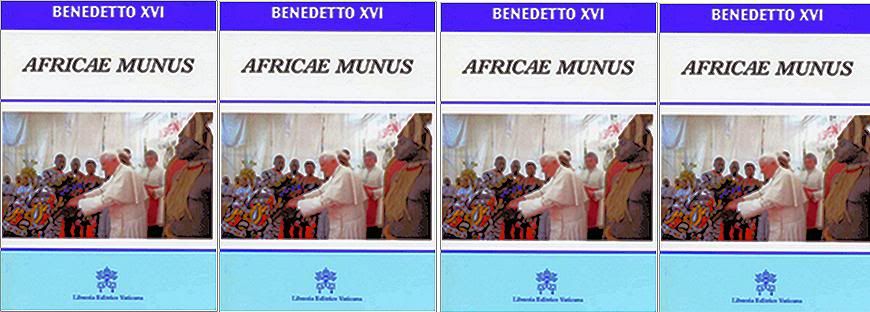
Reflecting on that moment, Sunday morning during Mass in Cotonou stadium, Pope Benedict said: “The Exhortation gathers the fruits of the Second Special Assembly for Africa of the Synod of Bishops, held in Rome two years ago, and it offers guidelines for the Church’s future mission on the continent. In the light of the Synod, the Church in Africa is called to deepened faith and commitment in the service to reconciliation, justice and peace”.
Earlier in comments in Italian, the Holy Father told pilgrims in the Aula Paolo VI: “In Africa I saw a freshness in their 'yes' to life, a freshness of religious awareness and of hope, a perception of reality in its totality with God and not reduced to a positivism which eventually extinguishes hope. All of this speaks of the presence on that continent of a reservoir of life and vitality for the future, on which we can count, on which the Church can rely."
One of the indelible images of the apostolic visit was the Pope's prayer at the tomb of a great churchman and illustrious son of Benin: “The unforgettable Cardinal Bernardin Gantin, whose revered memory is alive more than ever in his country, which regards him as a Father of the Nation, and the whole continent."
Pope Benedict spoke of the need for a spirit of reconciliation on the civil level, which he said “requires an openness to the hope that is animating sociopolitical and economic life of the continent, as I was able underline in the meeting with the political institutions, the Diplomatic Corps and Representatives of Religions. "
On that occasion the Holy Father stressed "the hope that should animate the path of the continent, noting that burning desire for freedom and justice, especially in recent months, which animates the hearts of many African peoples" :
"I also stressed the need to build a society in which relations between ethnic groups and religions are characterized by dialogue and harmony. I invited all to be true sowers of hope in every situation and environment. "
The Pope recalled his moving meeting with children: “In the parish church of Santa Rita, I really tasted the joy of living, the joy and enthusiasm of the younger generation, who are the future of Africa. Speaking to the ranks of festive children, one of the many resources and wealth of the continent, I pointed to the figure of St. Kizito, a Ugandan boy, who was killed because he wanted to live the Gospel, and I urged everyone to bear witness to Jesus to their peers."
He said his visit to the 'Peace and Jpy' children's home run by Mother Teresa’s Missionaries of Charity, was a moment of “great emotion, encountering sick and abandoned children, which allowed me to concretely see how love and solidarity know how to make the strength and love of the Risen Christ present in the midst of weakness”.
Finally he greeted pilgrims in various languages, including English: “I offer a cordial greeting to the Sisters of Jesus and Mary taking part in a course of spiritual renewal. I also greet the international group of Marist and Marianist Brothers. My warm welcome likewise goes to the pilgrims from Indonesia. Upon all the English-speaking visitors present at today’s Audience, including the groups from Nigeria, South Korea and the United States of America, I invoke God’s blessings of joy and peace”.

Here is a translation of the Pope's report:
Dear brothers and sisters,
I still have vivid impressions from my recent apostolic voyage to Benin, on which i wish to dwell today. My spirit spontaneously gives thanks to the Lord - in his Providence he has allowed me to return to Africa for the second time as the Successor of Peter, on the occasion of the 150th anniversary of the start of Benin's evangelization, and to sign and officially handd over to the African ecclesial community the post-Synodal Apostolic Exhortation Africae munus.
In this important document, after having reflected on the analyses and proposals that emerged from the Second Special Assembly on Africa of the Bishops' Synod, which took place at the Vatican in October 2009, I wished to offer some guidelines for pastoral activity on the great African continent.
At the same time, I also wished to pay homage and pray at the tomb of an illustrious son of Benin and of Africa - and a great man of the Church - the unforgettable Cardinal Bernardin Gantin, whose venerated memory is more than ever alive in his country which considers him a Father of the nation, and in the entire continent.
I wish to reiterate today my most sincere thanks to those who contributed to the realization of my pilgrimage. Above all, I am very grateful to the President of the Republic, who with great courtesy offered me his cordial greeting and that of all the nation; and to the Archbishop of Cotonou and the other venerated brothers in the episcopate who welcomed me with affection.
And I thank all the priests, religious, deacons, catechists and the numerous brothers and sisters who accompanied me with such faith and warmth during those three days of grace.
Together we lived a touching experience of faith and of renewed encounter with the living Christ, in the context of the 150th anniversary of Benin's evangelization.
I laid down the fruits of the Second Special Assembly for Africa of the Bishops' Synod at the foot of the Blessed Virgin, who is venerated in Benin most especially at the Basilica of the Immaculate Conception Ouidah.
On the model of Mary, the Church in Africa received the Good News of the Gospel, generating many peoples into the faith. Now the Christian community of Africa - as underscored by both the theme of the Synodal Assembly and the motto of my trip - is called on to renew itself in the faith in order to be even more in the service of reconciliation, justice and peace.
They are being invited to reconcile themselves internally in order to become joyous instruments of divine mercy, each one bringing his own spiritual and material riches to the common task.
This spirit of reconciliation is indispensable, naturally, even on the civilian level, and requires being open to hope, which must animate even the socio-political and economic life of the continent, as I had occasion to point out in a meeting with the leaders of political institutions, the diplomatic corps, and representatives of various religions.
.
On that occasion, I wished to put the stress on the hope that should animate the journey of the Continent, highlighting the desire for freedom and justice which, especially in recent months, has inspired the hearts of many African peoples.
I underscored the need to construct a society in which relationships between different ethnic groups and religions must be characterized by dialog and harmony. I called on everyone to be true sowers of hope in every grouping and in every field.
Christians are in themselves men of hope, who cannot be disinterested in their own brothers and sisters. And I recalled this truth even to the immense crowd that gathered for the Eucharistic celebration on Sunday in Cotonou's Friendship Stadium.
This Sunday Mass was an extraordinary moment of prayer and celebration in which thousands of faithful took part from Benin and other African countries. It was a wonderful testimonial of how faith can unite generations and can respond to the challenges inherent to every stage of life.
During this moving and solemn celebration, I consigned to the presidents of Africa's various episcopal conferences the post-Synodal Apostolic Exhortation Africae munus, which I had signed the day before in Ouidah, addressed to the bishops, priests, religious, catechists and lay faithful of the entire African continent.
Entrusting to them the fruits of the Second Synodal Special Assembly on Africa, I asked them to meditate attentively on it and to live it in fullness, in order to respond effectively to the demanding evangelizing mission of the pilgrim Cburch in Africa of the third millennium.
In this important text, every faithful will find the fundamental lines which will guide and encourage the journey of the Church in Africa, called on to become ever more 'salt of the earth' and 'light of the world' (Mt 5,13-14).
I appealed to all to be tireless builders of communion, peace and solidarity, in order to cooperate in the realization of God's plan of salvation for mankind. The Africans responded with enthusiasm to the Pope's appeal, and in their faces, in their ardent faith, in their adherence of conviction to the Gospel of life, I appreciated once more comforting signs of hope for the great African continent.
I touched these signs first-hand, as at the meeting with the children and their world of suffering. In the parish church of St. Rita, I truly savored the joy of life, the merriment and enthusiasm of the new generations who constitute the future of Africa.
To the festive ranks of children, one of the so many resources and riches of the Continent, I brought up the figure of St Kizito, an Ugandan boy who was killed because he wished to live according to the Gospel, and I called on all the children to bear witness to Jesus among those who are their own age.
The visit to the Peace and Joy children's home, run by the Missionaries of Charity of Blessed Teresa, made me experience great emotion to meet children who were abandoned and gravely ill, but which also allowed me to see concretely how love and solidarity can make present the power and affection of the Risen Christ even in the midst of frailty.
The joy and apostolic ardor that I encountered among the priests, religious, seminarians and laymen who were gathered in large numbers, constitutes a sign of sure hope for the future of the Church in Benin. I called on them to an authentic and living faith, and to a Christian life characterized by the practice of virtue.
I encouraged everyone to live the mission of the Church with faithfulness to the teachings of the Magisterium, in communion among themselves and with their Pastors, indicating to the priests especially the way of holiness, in the awareness that the priestly ministry is not simply a social function, but to bring God to man and man to God.
An intense moment of communion was my meeting with the bishops of Benin to reflect especially on the beginings of the Gospel announcement in their country by missionaries who generously gave their lives, sometimes in heroic manner, so that the love of God could be announced to everyone.
To the bishops, I addressed an invitation to carry out pastoral initiatives to inspire in families, in the parishes, in the communities and in ecclesial movements, a constant rediscovery of Sacred Scripture as a source of spiritual renewal and an occasion to deepen their faith.
From such a renewed approach to the Word of God, and from the rediscovery of one's own Baptism, the lay faithful will find the strength to bear witness to their faith in Christ and his Gospel in their daily life.
In this crucial phase for the entire Continent, the Church in Africa, with its commitment to serving the Gospel, with the courageous witness of actual solidarity, can be a protagonist in a sew season of hope.
In Africa, I saw a freshness of a Yes to life, a freshness of the religious sense and of hope, a perception of reality in its totality with God and not reduced to a positivism which, in the end, extinguishes hope.
All this says that in that Continent, there is a reservoir of life and vitality for the future, on which we cna count, on which the Church can count.
This trip of mine constitutes a great appeal to Africa, so that it may orient every effort to announcing the Gospel to those who still do not know it. It calls for a renewed commitment to evangelization, to which every baptized person is called, to promote reconciliation, justice and peace.
To Mary, Mother of the Church and POur Lady of Africa, I entrust those whom I was able to meet during this unforgettable apostolic visit. To her I commend the Church of Africa. May the maternal intercession of Mary, "whose heart is always oriented towards the will of God, sustain every task of conversion, consolidate every initiative of reconciliation, and make effiicient every effort in favor of peace in a world which hungers and thirsts for justice" (Africae munus, 175). Thank you.
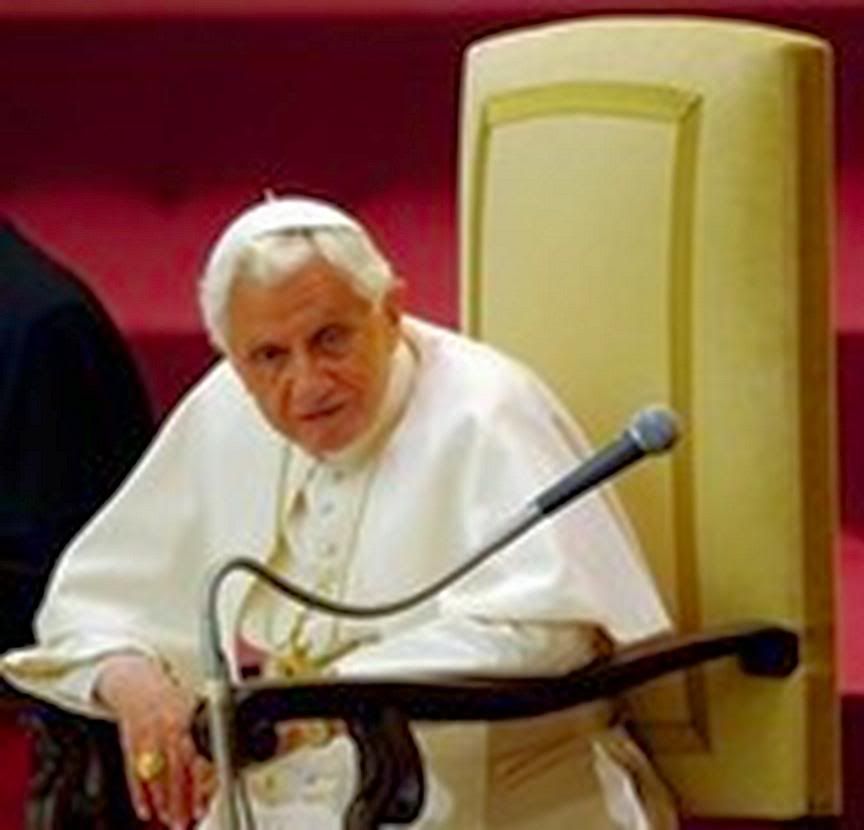
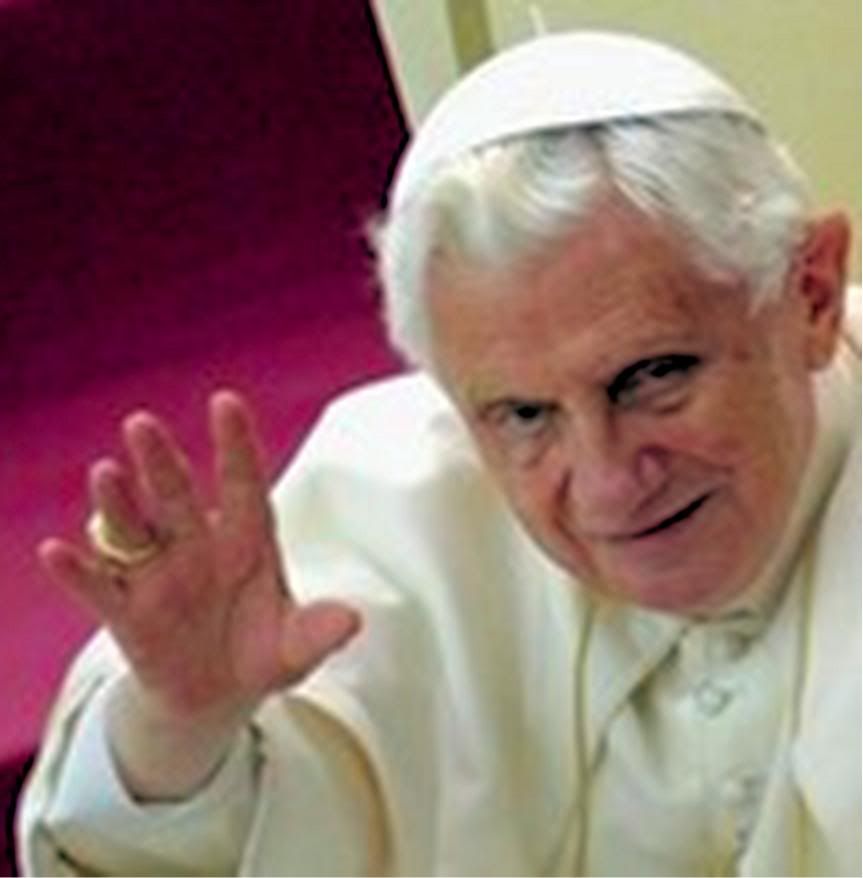
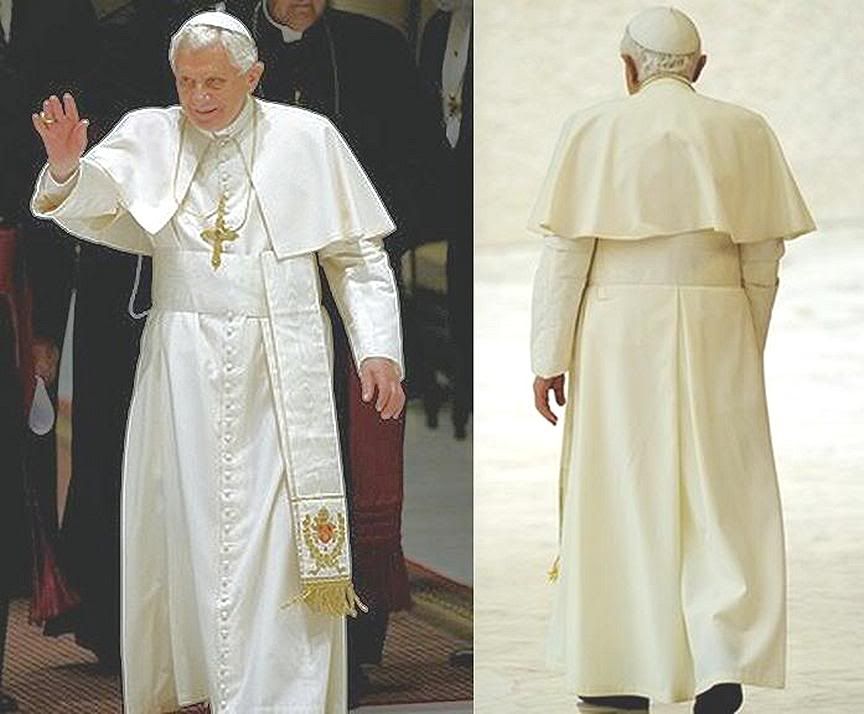
[Modificato da TERESA BENEDETTA 24/11/2011 17:07] |
| |
 24/11/2011 16:03 24/11/2011 16:03 |
|
| | | OFFLINE | | Post: 23.832
Post: 6.403 | Registrato il: 28/08/2005
Registrato il: 20/01/2009 | Administratore | Utente Master | |
|
 Thursday, November 24, 34th Week in Ordinary Time
Thursday, November 24, 34th Week in Ordinary Time
THANKSGIVING DAY (USA)
 ST. ANDREW DUNG-LAC AND COMPANIONS (Vietnam), Martyrs
ST. ANDREW DUNG-LAC AND COMPANIONS (Vietnam), Martyrs
Born in 1795, Andrew was a priest beheaded in Hanoi in 1839 for teaching the faith.
He is one of 117 martyrs who met death in Vietnam between 1820 and 1862. Members
of this group were beatified on four different occasions between 1900 and 1951, and
canonized by John Paul II in 1988. Andrew was beatified on May 27, 1900 by Leo XIII.
Readings for today's Mass:
www.usccb.org/bible/readings/112411-thanksgiving-day.cfm
AT THE VATICAN TODAY
The Holy Father met with
- 14 bishops and auxiliary bishops of dioceses in New York state on ad limina visit.
- Participants in the 40th anniversary meeting of Caritas Italia. Address in Italian.
A news conference presided by the Archbishop of Barcelo,a Cardinal Lluis Martinez Sistach, was held to present
the exhibit "GAUDÍ E LA SAGRADA FAMÍLIA DE BARCELONA. ARTE, SCIENZA E SPIRITUALITÀ", which opens today
in the Charlemagne arm of the Bernini Colonnade and will run through January 15, 2012. It is also a homage
to Benedict XVI who consecrated the Basilica of La Sagrada Familia in Barcelona last year. Unusually and
commendably, all the presentation statements at the news conference have been posted in all the Vatican languages.
 DEO GRATIAS FOR BENEDICT XVI...
DEO GRATIAS FOR BENEDICT XVI...
AD MULTOS ANNOS, SANCTE PATER!
 A BLESSED THANKSGIVING TO ALL!
A BLESSED THANKSGIVING TO ALL!
[Modificato da TERESA BENEDETTA 24/11/2011 17:09] |
| |
 24/11/2011 21:16 24/11/2011 21:16 |
|
| | | OFFLINE | | Post: 23.834
Post: 6.404 | Registrato il: 28/08/2005
Registrato il: 20/01/2009 | Administratore | Utente Master | |
|

 What an inspired decision by our beloved Pope! This is truly 'thinking outside the box' - and a strong signal to the Irish bishops and Irish Catholics in general!
Pope names a CDF sex-crimes 'prosecutor'
What an inspired decision by our beloved Pope! This is truly 'thinking outside the box' - and a strong signal to the Irish bishops and Irish Catholics in general!
Pope names a CDF sex-crimes 'prosecutor'
as the new Apostolic Nuncio to Ireland
by GERARD O'CONNELL

November 24, 2011
ROME - The new papal nuncio to Ireland is Monsignor Charles J. Brown, a priest from New York archdiocese, who worked closely with Cardinal Joseph Ratzinger, the future Pope Benedict, for eleven years at the Congregation for the Doctrine of the Faith.
The Irish Government gave its approval at a Cabinet meeting November 23. The Irish Times broke the news, but Vatican Insider has also gained independent confirmation from other sources. Fr Federico Lombardi, the Director of the Holy See’s Press Office would not comment on the news.
Monsignor Brown has worked at the Congregation for the Doctrine of the Faith since 1994 [where, according to a parallel story by AGI's Salvatore Izzo, Brown worked with Mons. Charles Sciculna, promoter of justice (in effect, chief prosecutor) for cases of sex abuses by priests that are referred to the CDF], and is the Adjunct Secretary of the International Theological Commission [which is an auxiliary body of the CDF].
Pope Benedict XVI knows him well, and sources say that in choosing him the Pontiff has shown particular “care and concern” for the Irish Church and Irish Catholics, and for Ireland as a state that has had diplomatic relations with the Holy See since 1929.
Described by those who know him as “very personable”, “pleasant and outgoing”, “good company”, Mgr. Brown is a scholar and “very hard working”. “He seems to be a very a good choice”, a source who knows the Irish situation well told Vatican Insider.
Mgr. Brown earned a history degree at the University of Notre Dame, and afterwards went on read Theology at Oxford University, and Medieval Studies at the University of Toronto. Furthermore, he gained a doctorate in Sacramental Theology from the Pontifical Athenaeum Sant'Anselmo in Rome.
It is unusual, but not without precedent, that the Holy See should decide to look outside its diplomatic corps for a suitable nuncio. It did so in this case, sources told Vatican Insider, to ensure that it found “the best man” to be nuncio in Ireland after a particularly tense period in relations between the Irish Government and the Vatican in the wake of the sexual-abuse of minors by priests’ scandal.
Since the major task of the nuncio in any country normally relates to the local Church rather than to the government, this is particularly true for the new nuncio to present-day Ireland where the Church has undergone, and to a degree is still undergoing, a traumatic experience as a result of the abuse scandal.
Mgr. Brown will have to support and promote the renewal of the Irish Church and probably also its structural reorganization in the wake of the recent crisis. He will have to encourage Irish Catholics, and will have to work hard to rebuild the bonds of trust and friendship between Ireland and the Holy See, which have suffered in the recent crisis.
The Irish Government, for its part, has sent the Vatican its nomination for a non-resident Ambassador to the Holy See, and it hopes that Rome will also give its approval very soon.
 A related item from George Weigel, who thinks that the Church in Ireland is over-structured as it is, and must be downsized for its own good...
Downsizing-to-grow in Ireland
A related item from George Weigel, who thinks that the Church in Ireland is over-structured as it is, and must be downsized for its own good...
Downsizing-to-grow in Ireland

Nov. 23, 2011 - Catholicism is in crisis all over Old Europe. Nowhere is that crisis more pronounced than in Ireland, where clerical corruption and disastrous episcopal leadership have collided with rank political expediency and a rabidly anticlerical media to produce a perfect storm of ecclesiastical meltdown.
The country whose constitution begins “In the name of the Most Holy Trinity…” is now thoroughly post-Christian. And while there has been no one cause of that radical secularization, the Church in Ireland had best look to itself, its sins, its errors and its unbecoming alliance with political power as it considers how to begin anew.
That reconsideration would be aided by dramatic Vatican action that includes a major downsizing of the Irish dioceses. There are currently four metropolitan sees and 22 dioceses in Ireland, for a total of 26 ecclesiastical jurisdictions.
Ireland’s total population is some 4.6 million, which is about the total Catholic population of the Archdiocese of Los Angeles. That there are 26 dioceses in Ireland is manifestly absurd.
So one step toward the reform of the Church in Ireland will be to rationalize what has become an irrational ecclesiastical structure: an overgrowth that has, over time, become an impediment to the Church’s mission.
And rationalizing, in this instance, means downsizing. It’s not a matter of retribution (“You made a colossal mess, so you have to be punished.”) The point is to create structures through which the new evangelization in Ireland, which is going to be a struggle in any case, can flow.
The downsizing should not be symbolic, but deep, mirroring the deep reform to which the Church in Ireland is called. Halving the number of current Irish dioceses by combining some sees and suppressing others would put an average of 354,000 Catholics into each restructured Irish diocese.
That’s still less than half the Catholics in Pittsburgh, so no complaints ought to be heard from Irish clergy or bishops about “draconian measures,” should the Holy See make a dramatic reduction in the number of Irish dioceses.
Then there is the question of replacing bishops. That many Irish bishops are resisting proposals for downsizing the number of Irish dioceses confirms the impression that the present Irish episcopal bench must be cleared: again, not as a matter of retribution (although in some cases deposition for malfeasance would certainly be warranted), but as an essential prerequisite to re-establishing a foundation of public confidence for the new evangelization of the Emerald Isle.
And in considering candidates for a reduced number of episcopal chairs in Ireland, the Holy See might well look outside, as well as inside, Ireland for candidates.
Michael Joseph Curley, the archbishop of Baltimore who confirmed my father, came to Baltimore as successor to Cardinal Gibbons in 1921. Curley was a native Irishman; he was ordained for what was then mission territory in Florida, where he served as a circuit-riding priest before becoming bishop of St. Augustine at age 34. Seven years later, he succeeded the most important Catholic churchman since John Carroll.
If this native of Athlone, educated in Limerick and Dublin, could become the archbishop of the premier see of the United States at a moment in American history marked by deep anti-Irish and anti-Catholic prejudices, it is not clear why (to take hypothetical examples) a native of Los Angeles educated in Denver, or a New Orleans native educated in Washington, D.C., could not become a bishop in Ireland today.
Twenty-first century Ireland is mission territory. The damage of recent decades has been so severe that it is not so much a matter of reforming the Church as of re-founding it: and re-founding it as a vibrant evangelical movement, not as a clericalist institution.
That re-founding will require institutional downsizing in the service of radical evangelization. That re-evangelization, in turn, will require bishops on fire with the Gospel, men who can make the Christian proposal compelling again amidst widespread cynicism and bitterness.
Men of that caliber can come from anywhere. Serious Irish Catholics will welcome them, whatever the place-of-birth recorded on their passports. [Modificato da TERESA BENEDETTA 26/11/2011 14:47] |
| |
 24/11/2011 22:47 24/11/2011 22:47 |
|
| | | OFFLINE | | Post: 23.835
Post: 6.405 | Registrato il: 28/08/2005
Registrato il: 20/01/2009 | Administratore | Utente Master | |
|

 ]
Christian charity gives hope
to a world searching for it,
Pope tells Italian Caritas

Nov. 24, 2011
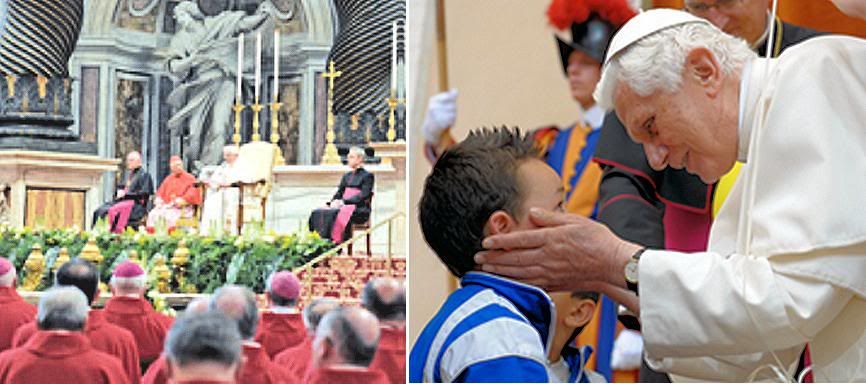
Humanity is searching for signs of hope in a world experiencing a period of profound change and where the divide between rich and poor is growing, and this hope lies in Christian charity, Pope Benedict said today to the members of Italian Caritas, gathered in the Vatican Basilica to celebrate the 40th anniversary of its foundation.
The Pope expressed his gratitude for their work on the field, in hospitals, shelters, parishes and homes throughout the peninsula. A work, he said, that must be rooted in three attitudes: listening, observation, discernment.
Another essential element, added the Holy Father, is the ability to have "a heart which sees" even when "the road is hard and our efforts do not seem to yield results" .
Pope Benedict also reflected on the major challenges of today that underline the need for brotherhood in a time of crisis. He spoke of the growing phenomenon of migration, the gap between the rich and poor nations of the world, and the violation of the human dignity of many people.
He said such challenges "require a charity that knows how to expand in concentric circles from small to large economic systems".
The Pope also pointed to the weakening of thje family as an institution and the uncertain conditions for young people, as grave causes for concern today.
The Holy Father called all those who operate within the Church to be sentinels throughout their area of jurisdiction indicating the sure path of the Gospel and the social doctrine of the Church, so that people in need may feel "the warmth of God through the open and welcoming hands of the disciples of Jesus."
In conclusion, he remarked: "The individualism of our day, the alleged sufficiency of technology, the relativism that affects everyone, call us to rouse people and communities to higher forms of listening, to the ability to open eyes and hearts to needs and resources, towards forms of community discernment on how to be and to live in a world in the midst of profound change."
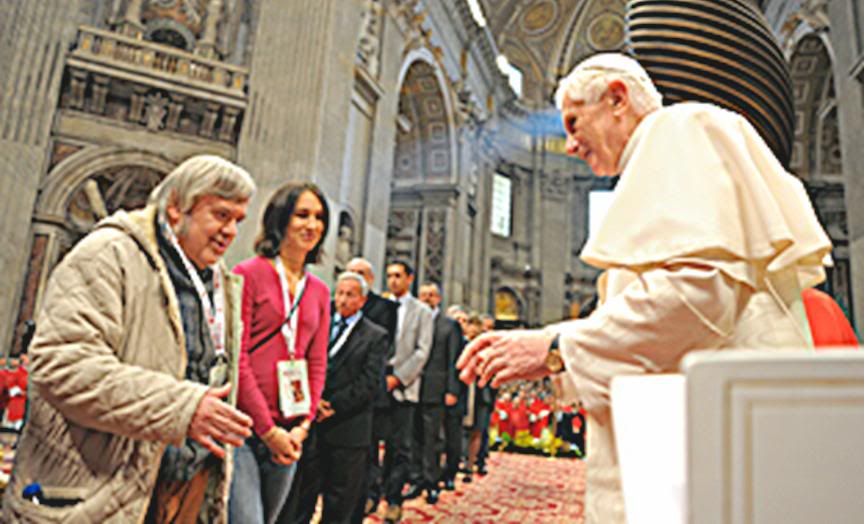 Here is a translation of the Holy Father's remarks:
Here is a translation of the Holy Father's remarks:
Venerated Brothers,
Dearest brothers and sisters:
I welcome you with joy on the occasion of the 40th anniversary of the institution of Caritas Italiana. I salute you with affection, and join in the gratitude of the entire Italian episcopate for your invaluable service.
I cordially greet Cardinal Angelo Bagnasco, president of the Italian bishops' conference, and thank him for the words he addressed to me in the name of everyone present.
I greet Mons. Giuseppe Merisi, president of Caritas, the bishops in charged with charitable services in the various regional conferences, the director of Caritas Italiana, the directors of thr diocesan Caritas branches, and all their co-workers.
You have come to the tomb of Peter to confirm your faith and renew the impetus for your mission. The Servant of God Paul VI, at the first national meeting of Caritas in 1972, said: "Above the purely material aspect of your work, there must emerge its predominantly pedagogic function" (Insegnamenti X [1972], 989).
Indeed, you are entrusted with an important educational task towards your communities, families, the civilian society in which te Church is called to be the light (cfr Fil 2,15). It means taking on the responsibility of educating in the good life of the Gospel, which can be done only if the witness to charity is understood in an organic manner.
The words of the Apostle Paul illuminate this perspective: "For through the Spirit, by faith, we await the hope of righteousness. For in Christ Jesus, neither circumcision nor uncircumcision counts for anything, but only faith working through love" (Gal 5,5-6).
This is the distinguishing feature of the Christian: the faith which makes him industrious in charity. Each of you is called to give his contribution so that the love with which God has loved us and will always love us becomes operative in our life in the power of service, in awareness of responsibility.
"For the love of Christ impels us," (2 Cor 5,14), writes St. Paul. It is this perspective that you must render ever present in the local Churches where you live.
Dear friends, never desist from this educational task, even when the way becomes difficult and the effort seems not to produce results. Live this mission in faithfulness to the Church and respecting the identity of your institutions, using the instruments that history has given you and those that 'the imagination of love' - as Blessed John Paul II liked to say - will suggest to you in the future.
In the past four decades, you have been able to study in depth, experiment and actualize a work method based on three attention points that are correlated and synergistic: to listen, to observe and to discern, a method placed in the service of your mission - to inspire charity within the communities and territories that you serve.
To listen in order to learn, certainly, but also to become close, to sustain the Christian communities in taking care of those who need to feel the warmth of God through the open and willing hands of the disciples of Jesus.
This is important: that suffering persons can feel the warmth of God and that they can feel this through your open hands and hearts. In this way, the Caritas branches should be like 'sentinels' (cfr Is 21,11-12), that are able to be aware and make others aware, to anticipate and to forestall, to sustain and to propose solutions along the sure way of the Gospel and the social doctrine of the Church.
The individualism of our day, the presumed sufficiency of technology, the relativism that influences everything, require that persons and communities be provoked towards higher forms of listening, to open their eyes and hearts to needs and resources, to communitarian forms of discernment of a way of being in a world that is undergoing profound change.
Going through the pages of the Gospel, we are struck by the actions of Jesus: actions that transmit grace, that educate in the faith and in discipleship. Acts of healing and welcome, of mercy and of hope, of compassion. Acts which initiate or perfect his call to follow him and which lead to the recognition of the Lord as the only reason fro the present and the future.
Actions and signs are inherent to the pedagogical or teaching function of Caritas. In fact, it is through concrete signs that you speak, evangelize and educate. A work of charity speaks of God, announces hope, leads persons to ask questions.
May you always be able to cultivate the quality of the works that you have invented. Make them able to 'speak', so to say, by concerning yourselves above all with the interior motivation that inspires them, and of the quality of the witness that comes from these works.
They are works that are born of faith. They are works of the Church, an expression of her attention towards those who need it most. They are pedagogical actions, because they help the poorest and the neediest to grow in their dignity, the Christian communities to walk following the way of Christ, civilian society to consciously assume its own obligations.
Let us recall what the Second Vatican Council teaches: "First of all, let the obligations of justice be fulfilled so that what is already owed in the name of justice may not be offered as a gift of charity" Apostolicam actuositatem, 8).
The humble and concrete service that the Church offers is not meant to replace, much less to put to sleep the collective civilian consciousness, but to be alongside in a spirit of sincere collaboration, with its own autonomy, and in full consciousness of subsidiarity.
From the beginning of your pastoral way, your priority commitment was to establish a presence throughout the territory, above all through the diocesan and parochial Caritas branches. This is an objective that must continue to be pursued in the present.
I am sure that your pastors will know how to sustain and orient you, above all by helping the community to understand the specific pastoral inspiration that Caritas carries in the life of every local Church, and I am sure that you will listen to your pastors and follow their instructions.
Attention to the territory you serve and animating it also elicits the ability to read how the lives of its inhabitants evolve, their difficulties and concerns, as well as their opportunities and prospects.
Charity requires an open mind, a wide vision, intuition and foresight,
'a heart that sees' (cfr Enc. Deus caritas est, 25). To respond to needs means not just to give bread to the hungry but also to inquire into the causes of this hunger, as Jesus did who could see the profound reality of the persons who sought his help.
In this perspective, conditions today interpellate your very way of being animators and workers of charity. We cannot help think beyond to the vast world of migrants. Often natural calamities and wars create emergency situations.
The global economic crisis is a further sign of the times that demands the courage of brotherhood. The gap between the world's North and South and the violation of human dignity of so many peoples, demands a charity that can broaden itself in concentric circles from small to large economic systems.
Growing unease, the weakening of families, the uncertainty of conditions for young people, indicate a risk of declining hope. Mankind does not just need benefactors, but also humble people who, like Jesus, can place themselves alongside their brothers to share their difficulties.
In a word, mankind seeks signs of hope. Our source of hope is the Lord. It is for this reason that there is a need for agencies like Caritas - not to delegate the service of charity, but that it may be a sign of Christ's charity, a sign that bears hope.
Dear friends, help the whole Church to make God's love visible. Live the spirit of free giving and help others to live it. Remind everyone of the essentialness of love that gives service, Be with your weaker brothers. Inspire the Christian communities. Tell the world the Word of love that comes from God. Seek the charity that is a synthesis of all the charisms of the spirit (cfr 1Cor 14,1).
May the Blessed Virgin Mary guide you, she who in visiting Elizabeth, carried the sublime gift of Jesus in the humility of service (cfr Lk 1,39-43). I will be with you in prayer, and I gladly impart the Apostolic Blessing, extending it to all those whom you meet daily in your many activities. Thank you.
Obviously, this is one of those 'routine' messages that was drafted for the Holy Father instead of being written by him directly. I cannot recall the last time I had to translate a more awkwardly worded and rambling papal message as this. No wonder the writer for Vatican Radio's English service had such an unwieldy lead paragraph that I had to cut in half to make it digestible! Just for the record, here was the RV lead:
Humanity is searching for signs of hope in a world experiencing a period of profound change and where the divide between rich and poor is growing. This hope lies in Christian charity. And this is why each one of us is called to make his or her contribution; “so that the love with which we are always and forever loved by God becomes diligence and strength in the service of life and awareness of our responsibility”, said Pope Benedict XVI on Thursday as he greeted the family of the Italian Caritas, gathered in the Vatican Basilica to celebrate the 40th anniversary of its foundation.
This message was probably drafted by people at Caritas Italiana, not at the Italian bishops' conference, since Cardinal Bagnasco's texts are usually a model of careful construction and direct, concrete language, but I do fault his office grievously, whoever prepared this message, for not vetting more conscientiously a text intended for the Pope.
[Modificato da TERESA BENEDETTA 25/11/2011 15:12] |
| |
 24/11/2011 23:51 24/11/2011 23:51 |
|
| | | OFFLINE | | Post: 23.836
Post: 6.406 | Registrato il: 28/08/2005
Registrato il: 20/01/2009 | Administratore | Utente Master | |
|

 Gaudì in Rome: A tribute
Gaudì in Rome: A tribute
to art, science and spirituality
by Cardinal Lluis Martinez Sistach
Archbishop of Barcelona
Translated from the 11/25/11 issue of

More than five thousand people filled the beautiful nave of the Sagrada Familia in Barcelona on November 6th to commemorate with a Eucharistic celebration the first anniversary of its solemn dedication by Pope Benedict XVI on November 7th 2010.
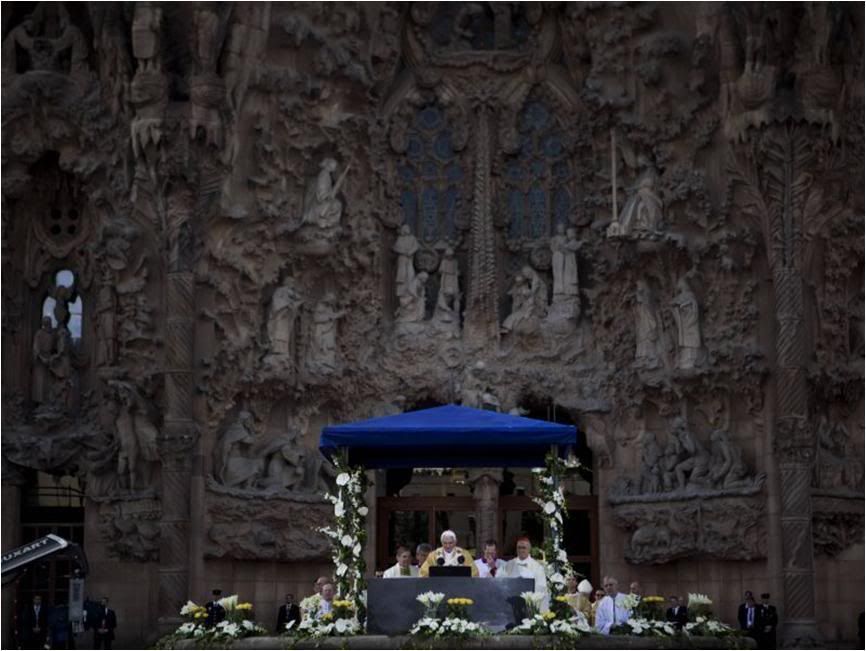
At the climax of the ceremony - having listened to a reading of a letter from the Holy Father to the Cardinal Archbishop on his priestly jubilee and the message of the Cardinal Secretary of State, in the name of the Pope, to the whole diocesan community – participants saw the figure of Benedict XVI appear on TV screens throughout the basilica and were able to hear from his lips the words he had pronounced that morning during the recitation of the Angelus.
The Pope had said, “I remember one year ago in Barcelona, I had the joy of dedicating the Basilica of the Sagrada Familia, an admirable synthesis of technique, beauty and faith, created by the servant of God Antoni Gaudi, a brilliant architect.”
Those gathered in the Sagrada Familia welcomed the Pope’s message with long applause. In that moment, we were all able to relive the joyful climate of that other Sunday, November 7 2010, when Benedict XVI was among us to dedicate the temple of the Sagrada Familia, to which he gave the title of minor basilica with the bull Templum Dei et Christifidelium communitatis, dated and sealed with the Ring of the Fisherman on that same day in Barcelona.
In listening to the Pope’s words, I remembered what he had said at lunch at the Archbishop’s House in Barcelona on the day of the dedication, “I will hold an indelible memory of this morning’s celebration.” It was very moving for us to hear once again that the Pope’s days in Barcelona gave him great joy.
We too hold moving and grateful memories of the Pope’s visit to Barcelona on November 6 and 7th. We felt – then as now – deeply loved by the Pope and called to revitalize our Catholic faith and tighten the bonds of communion with the successor of Peter.
This is what we wish to express with the exhibition “Gaudi and the Sagrada Familia in Barcelona. Art, Science, Spirituality,” which will be inaugurated on November 24th in the Carlo Magno wing next to St. Peter’s Square and will continue through January 15 of next year.
We were overjoyed to be able to bring to the Eternal City the work of a genial architect and an exemplary Christian, whose process of beatification has already begun.
Antoni Gaudì, the creator of the basilica of Sagrada Familia, is a Catalan who every day becomes even more universal. This exhibition in Rome is meant above all as an act of thanks to the Pope for the reasons cited above and to the Pontifical Council for Culture and the Pontifical Council for Promoting the New Evangelization for their interest and sensitivity towards the basilica and its brilliant architect, without forgetting the two initiatives organized by these dicasteries which will take place next year in Barcelona: the “Courtyard of the Gentiles” and the “Mission Metropolis,” which will take place in Barcelona and in other eleven European cities.
Gaudì said that in the temple of the Sagrada Familia everything is providential. Today, faced with the urgency of evangelization, we have in Barcelona a very beautiful and original religious monument, rich in biblical, ecclesial, catechetical and liturgical symbolism which constitutes an excellent instrument for evangelizing the men and women of our times.
Exhibit highlights the culture
of the Church in Catalonia
by JOAN RIGOL
Co-organizer of the Gaudi exhibit

November 24, 2011
Today, the proposal that Cardinal Ravasi made to the Fundació Joan Maragall three years ago, that of organising an event in Roman to showcase the cultural dimension of the Church in Catalonia, finally comes to fruition.
We could have chosen nothing better than Gaudí and La Sagrada Família for this purpose. In point of fact, our close relations with the Pontifical Council go back to 1988, when Cardinal Poupard advised in Barcelona on how best to establish an institution in the archdiocese to promote dialogue between faith, culture and religious sceptics.
The organising foundations have agreed that the exhibition that we open today should be accompanied by four institutional and academic parallel events.
Firstly, a solemn opening ceremony will take place this evening in the Atrium of the Pablo VI Audience Hall, followed by a tour of the exhibition in the adjoining Braccio di Carlo Magno and a dinner at the Spanish Embassy to the Holy See.
Those present will include around twelve cardinals and ten high-ranking officials from the Roman curia. Addresses will be given by cardinals Gianfranco Ravasi and Martínez Sistach, as well as by representatives from the organising foundations and the exhibition curator.
On December 12, a debate will take place at the MAXXI Auditorium on the subject of "Architecture: symbol and sacred. A century after Gaudí", at which the participants will include Cardinal Ravasi and the well-known architect Mario Botta, who has designed many beautiful and daring buildings, including several cathedrals. Dr. Maria Antonietta Crippa, the highest authority on Gaudí in Italy, will chair the debate.
Two days later, on December 14, the Spanish Embassy to the Holy See will invite us to enjoy two talks on Gaudí and his times. Dr. Ricard Torrents, former rector of the University of Vic, will focus on Catalonia, whilst Dr. Giovanni Maria Vian, director of L’Osservatore Romano, will centre on Italy. Dr. Antoni Matabosch will chair this debate
.
Finally, the official closure will take place in the Basilica de Santa Maria in Trastevere on January 13 with a concert on a Christmas theme by the Escolania choir of the Monastery of Montserrat.
All events will begin at 6 pm.
We hope that the exhibition and the parallel events will help you all to gain a deeper understanding of the artistic, cultural and religious of both the Catalan Church and our country’s culture.

[Modificato da TERESA BENEDETTA 25/11/2011 15:57] |
| |
 25/11/2011 17:28 25/11/2011 17:28 |
|
| | | OFFLINE | | Post: 23.837
Post: 6.407 | Registrato il: 28/08/2005
Registrato il: 20/01/2009 | Administratore | Utente Master | |
|
 Friday, November 25, 34th Week in Ordinary Time
Friday, November 25, 34th Week in Ordinary Time
 Portraits at left by Carlo Crivelli and Caravaggio; center panel shows scenes from the saint's martyrdom. Other images are uncredited.
ST. CATHERINE OF ALEXANDRIA (Egypt, 4th century), Virgin and Martyr
Portraits at left by Carlo Crivelli and Caravaggio; center panel shows scenes from the saint's martyrdom. Other images are uncredited.
ST. CATHERINE OF ALEXANDRIA (Egypt, 4th century), Virgin and Martyr
Another early saint whose known biography rests on legend. She is said to have converted to Christianity at age 18 after receiving a vision.
Under the Emperor Maximinus, she reportedly debated 50 pagan philosophers, who were so impressed by her wisdom that they became
Christians, as did about 200 soldiers and members of the emperor’s family. All of them were martyred. Sentenced to be executed on
a spiked wheel [which came to be known as the Catherine-wheel], it shattered at her touch. She was beheaded. Centuries later, angels
were said to have carried her body to the monastery built by Emperor Justinian at the foot of Mt. Sinai.
Readings for today's Mass:
www.usccb.org/bible/readings/112511.cfm
AT THE VATICAN TODAY
The Holy Father met with
- Cardinal Péter Erdő, Archbishop of Esztergom-Budapest (Hungary), and president of the Council of European Episcopal Conferences (CCEE), with other CCEE officails:
- Cardinal Angelo Bagnasco, Archbishop of Genoa, vice-president
- Mons. Józef Michalik, Archbishop of Przemyśl of the Latins (Poland), vice-president
- Mons. Duarte Nuno Queiroz de Barros da Cunha, Secretary-General
- Rev. Fr. Ferenc Janka, Vice Secretary General.
- Mons. Timothy Michael Dolan, Archbishop of New York, and his four auxiliary bishops, on ad limina visit
- Participants in the Plenary Assembly of the Pontifical Council for the Laity. Address in Italian.
In the afternoon with
- Mons. Luis Francisco Ladaria Ferrer, S.J., Secretary of the Congregation for the Doctrine of
the Faith (weekly meeting, usually with the CDF Prefect)

The Office of Pontifical Liturgical Celebrations has released the full calendar of public liturgical events
presided by the Holy Father for December 2011 and January 2012.
Thirty years ago today...
John Paul II named Cardinal Joseph Ratzinger, Archbishop of Munich-Freising, to be Prefect of the Congregation
for the Doctrine of the Faith. He assumed the position in February 1982 after winding up pending affairs in
the archdiocese.
 I'd like to quote what George Weigel wrote about this move by John Paul II in his biography WITNESS TO HOPE (pp442-444), under s chapter subheading called "The Universal Call to Holiness".
I'd like to quote what George Weigel wrote about this move by John Paul II in his biography WITNESS TO HOPE (pp442-444), under s chapter subheading called "The Universal Call to Holiness".
While Poland suffered through General Jaruzelski's 'state of war' and John Paul did what he could to support his countrymen, he took several internal initiatives that left large imprints on a Church standing at the threshold of the twenty-first century. [In 1999, when the book was first published, no one had any idea that this next step would 'produce' the first Pope of the third millennium!]
A Unique Partnership
Three weeks before Jaruzelski's coup against Polish society, John Paul made the single most important curial appointment of his papacy, naming Cardinal Joseph Ratzinger, archbishop of Munich-Freising since 1977, as Prefect for the Congregation for the Doctrine of the Faith (CDF).
Ratzinger was born on April 16, 1927, in a village in Upper Bavaria, the youngest of three children. His theological studies took place after the war at a time of great intellectual ferment in German Catholic circles.
After ordination to the priesthood, a postdoctoral dissertation on St. Bonaventure, and a year of parish work, Father Ratzinger became one of the youngest and most popular theology professors in Germany and an adviser to Cardinal Joseph Frings of Cologne.
Frings was the one of the leaders of the party of reform at Vatican II, and Ratzinger helped draft the cardinal's interventions, three of which played significant roles in setting the Council's course at its first session in 1962.
In the last phase of the Council, Ratzinger began to be concerned that some thinking about the Church's action in the modern world was getting uncoupled from the Dogmatic Constitution on the Church. Returning to Germany and a teaching position at the University of Tuebingen, Ratzinger became even more concerned by the radical direction several post-conciliar German theologies were taking, not least in their dalliance with Marxism.
When his intellectual colleagues at the Council, with whom he had helped establish the international theological journal Concilium, declined to challenge these trends, Ratzinger and a number of other influential Vatican II theologians (including Karol Wojtyla's friend Henri de Lubac, SJ) launched another journal, Communio, to promote what they regarded as a more authentic interpretation of the Council.
The Concilium/Communio split was not just an intellectual parting of the ways. Friendships were broken, and in the course of the ensuing polemics, Ratzinger found himself an object of contempt (odium theologicum, as it is sometimes called), in the eyes of some former colleagues.
Amid these controversies, he produced An Introduction to Christianity, based on his 1967 Tuebingen lectures, which was thoroughly contemporary in its use of biblical, philosophical, and theological materials.
Despite the important differences between the Concilium and Communio interpretations of Vatican II, both groups understood themselves to be heirs of the Council, and both were clearly opposed to Council rejectionists like the dissident French Archbishop Marcel Lefebvre. {It would have been helpful if Weigel had inserted a statement here to the effect that Lefebvre, as one of the Council Fathers, had signed all the Vatican II documents, and that his 'dissidence' came out in the open only after the implementation of the post-Conciliar liturgical reform.]
In the space of three months in the spring of 1977, Paul VI lifted Ratzinger out of his academic chair, named him archbishop of Munich-Freising, and created him cardinal. Ratzinger got to know Karol Wojtyla personally for the first time at the conclaves of 1978; the two had been exchanging books since 1974.
Shortly after his election, John Paul II, who wanted to make the Bavarian cardinal Prefect of the Congregation for Catholic Education, said to Ratzinger, "We'll have to have you in Rome".
Ratzinger replied that it was impossible so soon after his arrival in Munich: "You'll have to give me some time", he told the Pope.
When the Prefecture of the Congregation charged with promoting the Church's theological life and defending orthodoxy came open, John Paul asked again and, Ratzinger says, he "could not resist a second time".
For more than a decade and a half, Ratzinger was subjected to caricature as the fierce Panzerkardinal, heir of the Inquisitors, or as a gloomy German out of sorts with modernity.
In 1996 and 1997, when his attractive personality shone through a book-length interview [Salt of the Earth, with Peter Seewald], it was said that the cardinal had changed. He hadn't.
Those willing to look beyond the caricature when Ratzinger was appointed Prefect of CDF could find several important clues to John Paul II's thinking about the Church's post-conciliar theological situation.
First, Ratzinger's appointment indicated that the Pope took theology and theologians very seriously. By reason of his own contributions to theology and his encyclopedic knowledge of the Western theological tradition, Ratzinger was regarded by friend and foe alike as a theologian of the first caliber. Naming a man of this intellectual quality rather than a curial veteran as Prefect of the CDF was an expression of the Pope's eagerness to foster a genuine renewal of theology.
Ratzinger's appointment also suggested that the Pope wanted CDF to interact with the international theological community in a thoroughly contemporary way. John Paul did not appoint a medievalist or a patristic scholar as Prefect of CDF. [Though, I venture to say, Ratzinger was both, being steeped in the early to late medieval ages with his studies of Augustine and Bonaventure, and his immersion in the Fathers of the Church.] He appointed a theologian who had been deeply and critically engaged with contemporary philosophy and ecumenical theology.
Cardinal Ratzinger was the first man in his position in centuries who did not take Thomas Aquinas as his philosophical and theological master. The Pope respected Thomism and Thomists, but he broke precedent by appointing a non-Thomist Prefect of CDF. it was a clear signal that he believed there was a legitimate pluralism of theological methods, and that this pluralism ought to be taken into account in the formulation of authoritative teaching.
It made for an interesting partnership. The Pope was a philosopher; the Prefect was a theologian. John Paul was a Pole; Ratzinger was a German.
Karol Wojtyla had been one of the principal architects of the Pastoral Constitution on the Church in the Modern World [Gaudium et Spes]; a decade after the Council, Ratzinger was one of the sharpest critics of the way that document was being interpreted.
Over the course of his Pontificate, John Paul II would speak frequently about the twenty-first century as a possible 'springtime' for the Gospel after the winter of the twentieth century.
During the same period, Cardinal Ratzinger would deepen an alternative view, that the Church of the immediate future would be smaller and purer, not quite a catacomb Church, but certainly not the dominant force in Western culture it once had been.
Cardinal Ratzinger seemed to think that the West and its humanistic project had fallen into irreversible cultural decline. The Pope believed that a revitalization of humanism was possible. [But the two views are not mutually exclusive, in that the revitalization of humanism would necessarily start with Ratzinger's 'smaller and purer' communities.]
If, as one caricature had it, both John Paul II and Cardinal Ratzinger only spoke with people with whom they agreed, they could not have carried on an intense intellectual conversation for almost twenty years.
Ratzinger recognized in the charismatic, pastoral Wojtyla a 'passion for man' and a capacity to uncover 'the spiritual dimension of history', two traits that made the Church's proclamation of the Gospel a powerful alternative to the false humanisms of their time.
Wojtyla recognized in the shy, scholarly Ratzinger a contemporary intellectual who was a more accomplished theologian than himself. Together, they made a formidable intellectual team.
They had a regularly scheduled meeting every Friday evening, at which Ratzinger reviewed the Congregation's work with the Pope alone. Before and during lunch on Tuesdays, the two met frequently for more extended intellectual explorations, usually with others.
These luncheon discussions could involve a new encyclical or apostolic letter, a broader topic of concern (bioethics, the ecumenical situation, or the various theologies of liberation), or the themes of the coming weeks' general audience addresses.
John Paul, whom Ratzinger describes as "happy to have continuous work to do" amid his inevitably fragmented schedule, refined the later catecheses of the theology of the body and his six-year catechesis of the Creed (1985-1991) over these luncheon conversations, a distinctive feature of his Pontificate.
[Modificato da TERESA BENEDETTA 19/01/2013 11:50] |
| |
 25/11/2011 18:08 25/11/2011 18:08 |
|
| | | OFFLINE | | Post: 23.838
Post: 6.408 | Registrato il: 28/08/2005
Registrato il: 20/01/2009 | Administratore | Utente Master | |
|

 Benedict XVI:
Benedict XVI:
Apostle of anti-fundamentalism
by Fr. Alexander Lucie-Smith

November 25, 2011
Fr. Lucie-Smith is a doctor of moral theology. Author of several books, he was educated at Oxford and in Rome, and has lived in Malta, Italy, and Kenya. He is a regular contributor to the UK Catholic Herald.
It is encouraging to see that the Pope’s visit to Africa has elicited some balanced and appreciative comment in the Guardian [I must look this up] from Andrew Brown, who highlights what the Pope has to say about Muslims in his post-Synodal Apostolic Exhortation, Africae Munus.
The full text of the Pope’s words about Islam in Africa are to be found at paragraph 94, and they are worth quoting in full.
The Synod Fathers highlighted the complexity of the Muslim presence on the African continent.
In some countries, good relations exist between Christians and Muslims; in others, the local Christians are merely second-class citizens, and Catholics from abroad, religious and lay, have difficulty obtaining visas and residence permits; in some, there is insufficient distinction between the religious and political spheres, while in others, finally, there is a climate of hostility.
I call upon the Church, in every situation, to persist in esteem for Muslims, who “worship God who is one, living and subsistent; merciful and almighty, the creator of heaven and earth, who has also spoken to humanity.”
If all of us who believe in God desire to promote reconciliation, justice and peace, we must work together to banish every form of discrimination, intolerance and religious fundamentalism.
In her social apostolate, the Church does not make religious distinctions. She comes to the help of those in need, be they Christian, Muslim or animist. In this way she bears witness to the love of God, creator of all, and she invites the followers of other religions to demonstrate respect and to practise reciprocity in a spirit of esteem.
I ask the whole Church, through patient dialogue with Muslims, to seek juridical and practical recognition of religious freedom, so that every citizen in Africa may enjoy not only the right to choose his religion freely and to engage in worship, but also the right to freedom of conscience. Religious freedom is the road to peace.
It is only a short paragraph but it is full of good things. To me, it seems to be making several points, quite a few of them pretty robustly too.
Firstly, the situation is complex, that is, a mixed bag. There is no denying that Christians are persecuted by Muslims in several places and the institutional Church is subjected to legal harassment. Hence the insistence in the penultimate sentence on the reversal of institutional discrimination, through legislation and the courts, and the insistence on freedom of conscience, not just freedom of religious practice.
This is of course to be done through “patient dialogue”; the adjective suggests that it will not be easy. But it is encouraging that the Church is not ignoring the situation in countries that treat Christians badly.
The Pope knows what is going on, and he clearly wants the Church to respond to the situation in such a way that the situation can be righted. So, he is calling a spade a spade, and I for one am very pleased about this.
The second point to notice is that the Pope adopts an evangelical mindset based on Our Lord’s teaching about turning the other cheek. He clearly wants reciprocity between Muslims and Christians; but even where this does not exist, he urges us all “to persist in esteem for Muslims”.
This is clearly going to be challenging for many of us. Our goal is that Christians in Muslim-majority countries may enjoy the same rights as Muslims do in Christian-majority countries. (As far as I am aware, there is no Christian-majority country that places Muslims under any form of legal disadvantage.)
But the Pope clearly states that where this is not happening, we must continue to esteem Muslims. In other words we must love our persecutors. But this is no less than what our Lord himself said when he told us to love our enemies. The hope must be that by esteeming Muslims we will win them round to reciprocity. Is this naive – or is it a bold proclamation of the essence of the Christian gospel?
Third, the Pope quotes Nostra Aetate, the document of the Second Vatican Council on non-Christian religions, which is still our ultimate reference point and authority in inter-religious dialogue.
But he goes on to say that in promoting “reconciliation, justice and peace” – three good things – we need to banish three bad things – “discrimination, intolerance and religious fundamentalism”.
The first two have few friends in the world, but the last represents a bit of a bombshell. The Pope is against religious fundamentalism and wants it banished. This may come as news to some, but it ought not to.
The Pope has constantly advocated the path laid out by the Blessed John Paul II in Fides et Ratio (a letter that the Pope himself may well have had a hand in writing as Cardinal Ratzinger, or so it is said).
Faith and reason must go together; each one without the other is impoverished: religious fundamentalism is as deformed in its own way as the rationalism that so irrationally denies the supernatural.
Indeed the Church has been condemning fundamentalism for a long time now; the first Vatican Council in 1870 condemned it in the document Dei Filius. Thus it is always offensive and simply inaccurate to label the Pope himself as a fundamentalist. He is in fact the apostle of anti-fundamentalism.
Clearly, in a paragraph about Islam, the mention of fundamentalism calls to mind one particular brand of fundamentalism. On this matter the Pope is not giving an inch, and that is good.
In standing up against Islamic fundamentalism, he is in fact offering himself as an ally to all those Muslims (who must constitute the vast majority) who do not take the fundamentalist path. They can take heart from this, and so can we.
Note too that the Pope talks of “insufficient distinction between the religious and political spheres”. He is also standing up for a proper secularity.
Finally, with his gift for putting things succinctly, the Pope says “Religious freedom is the road to peace”. Quite so. Please God, may people hear this not just in Africa, but all over the world.
[There is, of course, the equally unacceptable Catholic 'fundamentalism' of those like the FSSPX members who would even deny the idea of religious freedom, considering it a 'violation' of Church teaching and tradition. They have seemingly equated Christ's mandate to 'go forth and preach the Gospel' to intolerance to the point of non-dialog with all those who have not yet heard or accepted the Gospel. Did they never hear of St. Francis and teh sultan? How can you evangelize unless you first communicate with those you would evangelize?[
[Modificato da TERESA BENEDETTA 25/11/2011 18:09] |
| |
 25/11/2011 22:10 25/11/2011 22:10 |
|
| | | OFFLINE | | Post: 23.839
Post: 6.409 | Registrato il: 28/08/2005
Registrato il: 20/01/2009 | Administratore | Utente Master | |
|

 Two articles today - one German, this one French - call attention to the fact that 30 years ago, John Paul II named Cardinal Joseph Ratzinger to lead the most important congregation of the Roman Curia, thus inaugurating a partnership that Jean Mercier, editor of the French Catholic magazine LA VIE, provocatively calls '30 years of a Pontificate'...
Thirty years of a Pontificate
Translated from
Two articles today - one German, this one French - call attention to the fact that 30 years ago, John Paul II named Cardinal Joseph Ratzinger to lead the most important congregation of the Roman Curia, thus inaugurating a partnership that Jean Mercier, editor of the French Catholic magazine LA VIE, provocatively calls '30 years of a Pontificate'...
Thirty years of a Pontificate
Translated from

November 25, 2011
Thirty years ago, on November 25, 1981, John Paul II named the Archbishop of Munich, Cardinal Joseph Ratzinger, to be Prefect of the Congregation for the Doctrine of the Faith.
It is certainly provocative to speak of thirty years of Pontificate when speaking of Benedict XVI - who has only been Pope for six years and seven months. But if Joseph Ratzinger was elected Pope in 2005, it is without a dobut because the Conclave chose continuity with the Pontificate of John Paul II.
The cardinals were well aware that the Pontificate of John Paul II rested, somehow, on the Wojtyla-Ratzinger 'ticket'. The two men, who cannot be more different in style, were in agreement on the basic fact that the Church has to return to the fundamentals of the faith. Which takes into consideration some indispensable elements of modernity (above all, ecumenical and inter-religious dialog).
Just as the great leaders of the Church in the 16th century achieved a Catholic Counter-Reformation, the Wojtyla-Ratzinger partnership put up a dam against a certain 'Protestantization' of the Catholic Church combined with the tsunami of secularization that were the basis for the anthropological turmoil that began in 1968 (notably, about the place of women in society and relationship to authority) [And how can you not fail to cite free unfettered sex at all costs as a central feature of this anthropolgical upheaval!] History will tell if the ticket will be considered to be a winning one.
What have been the great evolutions that have taken place in 30 years? What is the role that Joseph Ratzinger has played in them? Because of him, or thanks to him, essential changes have happened in 10 major domains.
1 Liturgy
Thirty years ago, amplified guitars and 'creative' liturgical innovations seemed to predominate at Masses. In France, it was rare for a priest to say Mass in a chasuble, a garment that was considered 'superficial' and not in keeping with the supposed 'poverty' of the Church. Latin was, with rare xceptions, an 'accessory' used only by traditionalist groups. Eucharistic adoration and the rosary were considered the peak of tackiness.
In 2011, it is otherwise. Eucharistic adoration has become a 'must' even in parish gatherings. Priests born after the Second Vatican Council are not embarrassed to ear the chasuble, and even wear embroidered ones if they have it. Incense and Latin are now part of the Mass. And Gregorian chant is an added luxury.
Cardinal Ratzinger is not a stranger to this return to traditional expressions of the liturgy. He wrote abundantly on the subject, and foresaw a 'reform of the reform', namely, a traditional stylization of the Novus Ordo.
As Pope, he has since restored the traditional Mass to full 'legitimacy'; through the Motu Proprio Summoruum pontificum in 2007. Now, there are two forms of the Roman rite: the extraordinary (Tridentine) and the ordinary (post-Vatican II) - and the Pope hopes that practice of the two forms will lead to their mutual enrichment.
2 Display of Catholic identity
Thirty years ago, 82% of the French population still considered themselves Catholic - not far from the 90% right after the Second World War. Of course, the actual practice of Catholicism had already fallen quite a ways, but acknowledged membership in the Church was still what it was.
This meant that the French still possessed the 'codes' of Catholicism. - codes which continued, amidst the turmoil of Vatican II and the so-called opening to the world, to advocate a Catholic presence int eh world as 'yeast for the dough' and to announce the Christian message implicitly by setting an example of Christian living, for as long as society still retained something of Christianity.
But European society would soon thereafter find itself 'exculturated' of Christianity, to use an expression from Danièle Hervieu-Léger). Which required therefore that practising Catholics, who had fast become very much in the minority, should make their presence count, to proclaim their faith clearly to people who no longer even knew who Jesus is.
Young priests started using the Roman collar again (and some, though not traditionalists, now even use the cassock all the time). Such attitudes explain the success of gatherings like World Youth Day in which participants affirm a Catholic self-assurance as well as a spiritual attitude worth emulating.
Sicne the 1990s, Cardinal Ratzinger saw that the future of the Church would be in small communities that would be prayerful and evangelizing, as he confided in his interview books.
As Pope, he has explained that the future of mankind itself rests with these 'creative minorities', and insists Chat Catholics must bear explicit witness to the faith in the context of the New Evangelization.
The paradigm has completely changed: Catholics, being in the minority, are thus pqradoxically 'authorized' to ne more affirmative, more identifiably Catholic.
3 Transmitting the Christian message
At the start of the 1980s, the catecheses resulting from post-Vatican II doctrinal chaos had completely broken with the dogmatic teaching that was still in force during the 1960s. This was replaced by 'creative pedagogy' and the inductive method. [For example: Before speaking about the Lord's call on Abraham to leave his birthplace, the new catechists would first drill the children on what it means to move from your old home to a new one, emphasizing their own personal experience of a situation.]
In 2011, the effectiveness of such an inductive method is under serious question. Most Catholics now in their 40s have retained little of what was taught to them in that way, and so, pedagogical creativity has failed to live up to its 'promises'. Once more, we are learning the effectiveness of prayers learned by heart, on whose 'contents' one may wish to reflect.
Since 1983, after a trip to France, Cardinal Ratzinger criticized the new catechetical methods reuslting from Vatican II and asked for a return to the traditional methods which stressed content over method.
In 1986, he began the titanic job of compiling a new Catechism of the Catholic Church (in part to neutralize the liberal catechisms that were bign published by local Churches, such as that of the Netherlands) [and on the recommendation of the Special Synodal Assembly on the Reception of Vatican II, convoked by John Paul II in 195], which was published in 1992.
In 2011, YOUCAT - an abridged catechism presented in Q&A form for young people at World Youth Day in madrid - was not quite a success [????], with the participants electing to attend the catecheses held by more than 200 bishops. [I don't think YOUCAT and the actual catecheses at WYD were mutually exclusive at all. Each participant got a copy of YOUCAT, which they can read and review as and when they want to, while the bishops' spoken catecheses were necessarily limited to specific topics.]
4 Ideology
In 1976, Maurice Clavel, in his thunderous essay Dieu est Dieu, nom de Dieu, lashed out at Christians fascinated by Marxism and its power to inspire, whereas they thought Christianity had 'missed the boat' of modernity.
In 1981, with the electoral victory in France of Francois Mitterand, some Catholics saw the triumph of the left as a prophetic event. Many practising Christians were at the time deeply involved in the human sciences and psychoanalysis and were enamored with structuralism.
In 2011, Marxism has nothing to say to anyone, and Communism has faded after the fall of the Berlin Wall. On the other hand, some Catholics seem to be tempted by the ideology of the extreme right, a kind of neo-Maurrasism that feeds on anti-Muslim discourse. [The reference is to Charles Maurras (1868-1952), leader and principal thinker of Action Française, a political movement that was monarchist, anti-parliamentarian, counter-revolutionary and ultra-nationalist. A major intellectual influence in early 20th-century Europe, his views anticipated some of the ideas of fascism.
Where was Cardinal Ratzinger in all this? Some time before the Conclave of 2005, he had deplored the 'snobbism' that had led some Catholics to all kinds of 'doctrines' in vogue, reiterating tirelessly that Christianity is not an ideology but an encounter with the person of Christ.
5 The protagonists
Thirty years ago, at least in France, Catholic Action, very structured, still dominated the parishes. In contrast, the charismatic communities* were looked on with some disdain or even suspicion. And sometimes with reason, because some of these movements have bene known to commit serious deviances. It is almost the opposite these days, when French bishops trust communities like Chemin Neuf (New Way) and Emmanuel to renew the parishes.
[The term 'charismatic' communities is misleading when it refers to the new ecclesial movements in the Catholic church, like Opus Dei, C&L, Focolari, etc - which each claims a specific and distinguishing 'charism' or grace. The term confuses them with the 'evangelical charismatics', of which the Church has quite a few, which resemble the 'Pentecostal charismatics' in their born-again fervor and belief in a mass evocation of the Holy Spirit.]
Those who are in control in the Church these days tended in the years from 1975-1985 to 'stay below the radar'. Many bishops today say that 30 years ago, as seminarians or young priests, self-styled 'adult Catholics' looked at them askance because they were too 'classic' or pious.
Today, the situation is completely different. There are different actors on the scene, and the current cadres of the Church are the proof. Of course, the Pope himself is among these paradoxical cases. Once scorned as 'too harsh', the esrtwhile Panzewrkardinal now leads the Church.
6 Taking a stand
Committed priests and laypeople 30 years ago were impelled by the need to make the Gospel credible in the eyes of the world through strong positions, especially in social activities - thus favoring a kind of activism at a time when the Church was courting strong recognition by society. It had only been 15 years sicne the end of Vatican II and its dynamic of aggiornamento [tp be up to date]: The Church had changed its relationship with the world - it had chosen to be open, and the world had to take note!
Thirty years later, Catholics have been stripped of such pretensions. The pedophile scandals [because of information globalization, events which take place far from us loom large on our horizon] have associated the Church with the worst sins. Priests are systematically suspected of being perverted if they hold to their vow of celibacy.
In terms of image, the Church is flat on her face. Is is no longer the case that Catholics should seek ceaselessly to show that they are good folks, since a certain media 'doctrine' presents them otherwise.
Benedict XVI quickly understood the gain that could be drawn from this apparently sad development: The Church should do penance, and it serves a purpose that it is so badly seen these days. And that is why the Pope lays such emphasis on the theology of grace, because God gives his grace to the man who is weakened by sin: "God is not interested in how many times you fall, but in how many times you can get up," he told the young people of Freiburg last September.
7 Relationship with other faiths
Thirty years ago, the Church's confrontation with other religions was strongly focused on the ecumenical dialog and rapprochement with Judaism. (Let us recall that 1981 was the year that the Jewish-born Cardinal Jean Marie Lustiger became Archbishop of Paris.]
In fact, if the dialog between Protestants and Catholics was a cause for great enthusiasm then, a sort of routine and disillusion have taken its place, linked to the evolution of the actors involved. The same can be said, more or less, of relations with the JEws.
In 2011, the question of 'the other' has polarized around dialog with Islam (5 million Muslims in France), with the evangelical church, and also with the Lefebvrians...
Joseph Ratzinger has followed these changes with a critical eye - one sees this in the Regensburg lecture - but also a welcoming attitude - consider his 'remake' of Assisi last October, which also stressed his continuity with John Paul II.
8 The priest
The 1970s and the start of the 1980s confirmed a stunning mutation of the role of the priest, who came to be valued much more for his social function, linked to secularization (most priests stopped wearing the cassock). He was no longer necessarily the man who administered the sacraments, thus carrying in himself a sacred aspect. Many parish priests refused to be bound to a sacramental status, which, they claimed, cut them off from other people.
Thirty years have passed during which two Popes have insisted vigorously on leading priests back to their traditional role. In 2009, Benedict XVI launched a Year for Priests revolving around the model of the Curate of Ars, St. Jean Marie Vianney, a figure execrated by most priests older than 50.
One is now witnessing a return to appreciating the sacred ontology of the ordained ministry, which upsets those who see in this a danger of clericalism.
Benedict XVI is the worthy successor of John Paul II in carrying on his work. [Too bad Mercier uses the expression 'successor of John Paul II' too casually and mistakenly. Benedict XVI is the Successor of Peter, just as all the other Popes have been, not of his immediate predecessor!]
It goes without saying that the young people who commit themselves to the priesthood these days have less difficulty than those preceding them in taking on the original sense of priesthood.
9 Holiness
Thiry years ago, John Paul II had just begun what would be an intensive program of canonizations and beatifications. Publicly-acclaimed 'saints' are still familiar daily figures in our media, like Soeur Emmanuelle and the Abbe Pierre. Things have changed a lot, and not just because they have died.
French Catholics - over a rather wide spectrum of sensibilities - have, for instance, recovered from relative oblivion the figure of Therese of Lisieux who has become a true and proper 'star' - the object of a cult of relics and many books, etc.
One is witnessing the veneration of young saintly figures who like her, were very young and suffered much, like Claire de Castelbajac, Agnès de Nanteuil, Chiara Luce Badano. Likewise, the French public appear to have rediscovered the ways of Marian devotion.
This tendency must please the Pope who never misses an occasion to speak of holiness - never as a dream of perfection, but always as a state of relationship with Christ. This return to the idea of holiness - a word that not too long ago caused great fear, too much fear ['discomfort' perhaps is the better word] - comes with the return of knightly imagery [Really ????] which was unthinkable 30 years ago.
Redemptive suffering, which is emphasized in Benedict XVI's JESUS OF NAZARETH, Vol. II, has also made a 'comeback' when not so long ago, the very idea was 'taboo'.
10 Prayer and the sacred
It would be difficult to say outright that people prayed less 30 years ago, but there is evidence of this. Catholics who are immersed in city life are much more aware these days of the need for silence and contemplation, where once, they opposed contemplatives who prayed, in favor of activists 'who could change the world'.
Praying the rosary and Eucharistic Adoration have become current again in the Church, especially among young people. Prayer schools are flourishing.
Benedict XVI does not cease to incarnate this reality since he has systematically imposed pauses for meditation during his liturgies, and frequently presides at Eucharistic Adoration with the faithful.
Parallel to this evolution, the Pope has insisted on the sacrificial aspect of the Mass that induces a prayerful and focused offering, as opposed to exuberant Masses in which silence is not allowed.
I have not had time to really and comprehensively think through the high points of Benedict XVI's Pontificate so far, but the one omission I see in Mercier's list is BenedicT XVI's pro-active work as Vatican legislator, much of it historic and unprecedented - from the liturgy to sex crimes to Vatican finances. Sandro Magister did a good story on this not too long ago...
[Modificato da TERESA BENEDETTA 27/11/2011 00:52] |
| |
 26/11/2011 02:43 26/11/2011 02:43 |
|
| | | OFFLINE | | Post: 23.840
Post: 6.410 | Registrato il: 28/08/2005
Registrato il: 20/01/2009 | Administratore | Utente Master | |
|

 Pope Benedict on rejecting God
Pope Benedict on rejecting God
and the global crisis today

Nov. 25, 2011
World Youth Day in Madrid and the 2010 Congress for Asian Laity were the major projects of the Pontifical Council for the Laity in the past year or so.
And these were the subjects Pope Benedict chose to reflect on when he met participants attending the 25th Plenary Assembly of the Pontifical Council for the Laity on Friday.
At the Clementine Hall of the Apostolic Palace, Pope Benedict said that both the lay Congress and World Youth Day in Madrid had been hugely important in the evangelizing mission of the church and were key focal points on the road to the thirteenth General Assembly of the Synod of Bishops on evangelization due to take place next year.

Regarding the Congress for Asian Laity held in Seoul, South Korea, in September 2010, the Pope said “the conference provided an opportunity for the laity, associations, movements and new communities operating in Asia, to strengthen the commitment and courage for the Church’s mission.”
A mission he added, to be undertaken in "a vast continent that is home to people of different cultures and religions of ancient origin, who often live the faith in difficult circumstances, sometimes even suffering persecution."
Speaking enthusiastically about World Youth Day in Madrid this summer Pope Benedict recalled how he was filled with joy seeing youth from around the globe illuminated by hope, said he was looking forward to celebrating the next gathering in Rio de Janeiro in 2013.
Turning his attention to the theme of the Council's Plenary Assembly this year - "The question of God today" - the Pope said that we should never tire of asking that question again and again in a time when there is a growing mentality that would deny any reference to God.
He said it is a mentality that has led to the global crisis today - s a crisis of meaning and values, one that had gathered pace even before the economic crisis began.
Finally, the Pope ended with words of encouragement, saying the Church needs the contribution of all its members, especially the lay faithful, in order to carry out its mission.

[Modificato da TERESA BENEDETTA 26/11/2011 02:54] |
| |
 26/11/2011 04:45 26/11/2011 04:45 |
|
| | | OFFLINE | | Post: 23.841
Post: 6.411 | Registrato il: 28/08/2005
Registrato il: 20/01/2009 | Administratore | Utente Master | |
|

 The new Nuncio to Ireland
The new Nuncio to Ireland
is a most welcome appointment
Editorial

November 25, 2011
THE VATICAN’S appointment of an Irish American as its new papal nuncio to Ireland is welcome news and reflects the seriousness of Rome’s intent to put relations between itself and this State on an altogether new footing.
That Msgr Charles Brown is not a usual Vatican diplomat but comes with a background at the Holy See’s Congregation for the Doctrine of the Faith (CDF), most uncommon for a papal nuncio, is an indication of the thought Rome has put into this appointment.
At the CDF since 1994 where he worked for 11 years with Cardinal Joseph Ratzinger, then dean of that congregation, before the latter was elected Pope in 2005, Msgr Brown is not only familiar with the Pope’s thinking but also with the Church’s response to the issue of clerical child sexual abuse.
In 2001, in an attempt to bring uniformity into how that issue was being dealt with by the worldwide church, Cardinal Ratzinger wrote to all Catholic bishops asking that they refer to the CDF all credible allegations of such abuse. He and the CDF would then decide whether these should be dealt with locally or by Rome. This meant that, very soon, no other Vatican congregation was as familiar with the issue as a phenomenon within the Church as was the CDF.
Thus, Msgr Brown will arrive in Ireland with two major advantages over very many of his predecessors as papal nuncio. As an Irish American he will have an intuitive understanding of the Catholic people of this State and of this island. As a man who has served at the CDF for 17 years he will be deeply familiar with the issue that has plagued the Irish Catholic Church for almost two decades.
But his appointment should be welcome for other reasons. It will mark a new beginning and the resumption of more normal diplomatic relations between Ireland and Rome.
In the furore over the Government’s decision to close Ireland's Embassy to the Holy See, some have assumed that it marked an end to diplomatic relations between this State and the Vatican. That was never the case.
As the Government announced at the time, Ireland will maintain its diplomatic relations with the Vatican and its ambassador to the Holy See, resident in Dublin, will be the most senior figure in the Department of Foreign Affairs, its secretary general.
For the majority of our citizens and for most Catholics on this island, the announcement of Msgr Brown’s appointment will be welcomed as an opportunity to make a fresh start in relations with the Holy See. [Modificato da TERESA BENEDETTA 26/11/2011 04:46] |
| |
 26/11/2011 14:30 26/11/2011 14:30 |
|
| | | OFFLINE | | Post: 23.842
Post: 6.412 | Registrato il: 28/08/2005
Registrato il: 20/01/2009 | Administratore | Utente Master | |
|
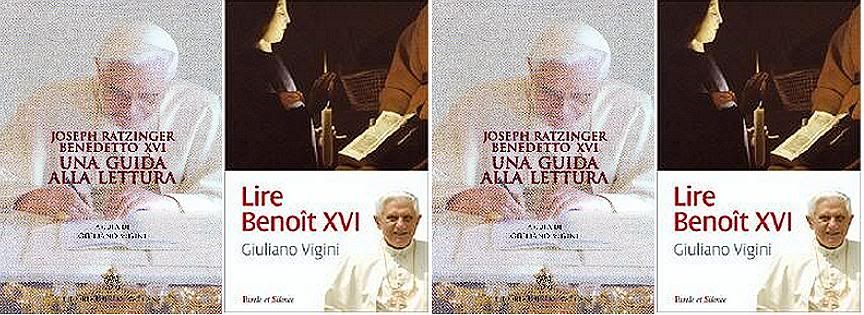 Much as I think I would get immediate wind of any new book about Benedict XVI, at least in Italy, what chagrin to find out about this one only because it has already been translated to French - though it just came out In Italian in August! Thanks to Beatrice, who also furnishes excerpts from the Preface to the French edition...A publisher's note also says that Vigini's notes on 'how to read Benedict XVI' 'include JESUS OF NAZARETH, Vol. 2.... The Italian title translates as 'A Guide to Reading Joseph Ratzinger/Benedict XVI', and the French is 'Reading Benedict XVI'
Peter's shadow
Much as I think I would get immediate wind of any new book about Benedict XVI, at least in Italy, what chagrin to find out about this one only because it has already been translated to French - though it just came out In Italian in August! Thanks to Beatrice, who also furnishes excerpts from the Preface to the French edition...A publisher's note also says that Vigini's notes on 'how to read Benedict XVI' 'include JESUS OF NAZARETH, Vol. 2.... The Italian title translates as 'A Guide to Reading Joseph Ratzinger/Benedict XVI', and the French is 'Reading Benedict XVI'
Peter's shadow
in the light of Christ
by Giuliano Vigini
Excerpt translated from the Preface to
'Lire Benoit XVI'
'Co-worker of the truth' (Mitarbeiter des Wahrheit) was the episcopal motto - taken from a verse of John's third Letter (3, Jn 8) - chosen by Joseph Ratzinger when he was named Archbishop of Munich-Freising on March 25, 1977 and his episcopal ordination on May 28,
This motto may well be emblematic of the spirit that has always guided the theologian, the pastor, the Prefect of the Congregation for the Doctrine of the Faith, in his search for and service to the truth.
In all his functions, in each of the responsibilities with which he has been entrusted, Joseph Ratzinger has always thought that his mission is not to speak or act in his own name, but to speak and act in the name of the truth of Christ, with the Church and for the Church.
And now that he bears the weight of the greatest responsibility and service to which he has been called, recourse to that spirit has become a permanent leitmotiv: to exhort everyone, especially priests, not to forget the ultimate purpose of their ministry, nor the humility necessary in exercising it, in communion with all the Church.
Without allowing himself to be influenced by the malicious interpretations or the preconceived judgments that continued to be forged about his person and actions since he became Pope, Benedict XVI simply has gone to work, with patience and firmness, serenity and confidence, in the vineyard of the Lord.
In his writing, we begin to see the quality of what he is sowing, to appreciate his intellectual acuity, but also his great spirituality that is capable of transcending the barriers of his retiring and reserved character.
One understands, in other words, that Benedict XVI does not merely speak as a theologian, but a pastor who wishes above all to transmit the beauty and the joy of a personal encounter with Christ. Because the center and the living heart of Christianity can be found in the encounter with the Word made flesh, who every day makes life for us.
For this reason, among the tasks to which Benedict XVI has consecrated himself most attentively and assiduously, aware of its primordial importance in the framework of his mission to evangtelize, there is his ministry of preaching and of catechesis - a ministry that is carried out through reflections rich in theological content, permeated by a strong spiritual charge, conveyed with the intelligence of faith but also by the wisdom of the heart, in order to achieve his ultimate goal as Successor of Peter, his mandate to confirm his brothers in the faith (Lk 22,32), both in watchign voer them and leading them to communion with Christ, so that all may be one with him, Lord of everyone....
The mission of Peter, in the context of the institution of the Eucharist, indicates that his duty in the Church as "the eucharistic community and thus, a communion within the Mystical Body of the Lord" is precisely to preside over the universal communion, tgo the "community of this love which comes from Christ and ever new surpasses the limits of privacy to bring the love of Christ to the very ends of the earth".
This role is not exercised in the manner of some governmental responsibility or mission of human societies, but as a service of 'the servant of servants' towards the faith of the Church: listening to the Word of God, in the intimacy of the Fathers and masters of the faith, in the school of saints, following the history of a long tradition.
Although it is a summary, the short course traced in the book on how to read the teachings of Benedict XVI wishes to be a contribution in the grasping the spiritual dynamism of this Magisterium and to indicate the guidelines of his Pontificate.
Giuliano Vigini (born in Milan 1946) ie one of the best-known Catholic writers in Italy. He has authored 200 publications and contributes to several newspapers and magazines, including Corriere della Sera and Avvenire, Vita e Pensiero, Jesus and Famiglia cristiana. He teaches contemporary socilogy at the Catholic University in Milan.
 Another book released this month:
Another book released this month:
 IN CAMMINO CON BENEDETTO XVI
IN CAMMINO CON BENEDETTO XVI
Fede cristiana e vita nel mondo
[Walking with Benedict XVI:
Christian faith and life in the world]
by Fr. Federico Lombardi, SJ
It is a selection from the weekly editorials that Fr. Lombardi has been writing
for Vatican Radio and CTV over the past several years.
P.S. I know the Joseph Ratzinger/Papst Benedikt XVI Stiftung (foundation established by the Ratzinger Schuerlerkreis) is keeping track of all the published works by and on Benedict XVI, but I wish someone in that Foundation would publish a progress report of sorts on exactly how many books have been written about Benedict XVI since he became Pope.
Surely, no other Pope has had so many books written about him in such a short time, an astounding fact for someone most MSM commentators dismissed when he was elected as someone who would probably be, at best, a footnote in history. A 'footnote' that has since been generating a formidable library all by itself. Indeed, books-by-and-on-Benedict seem to have become a sui generis publishing industry!
George Weigel gives a listing of the books in English about JP2 that he cites in WITNESS TO HOPE, and it shows 10 that were written in 1978-1979, seven written between 1980-1985, and the rest written mostly in the 1990s. Of course, his bibliography cites only the works he actually consulted, not all the books ever published. Still, it would be no surprise, given the way the Benedict XVI book industry has been doing, if the number of books written about Benedict XVI in six years and seven months would by now equal if not surpass all the books ever written about John Paul II in the 26 years of his Pontificate and since.
[Modificato da TERESA BENEDETTA 26/11/2011 17:23] |
| |
 26/11/2011 15:52 26/11/2011 15:52 |
|
| | | OFFLINE | | Post: 23.843
Post: 6.413 | Registrato il: 28/08/2005
Registrato il: 20/01/2009 | Administratore | Utente Master | |
|
|
| |
 26/11/2011 17:07 26/11/2011 17:07 |
|
| | | OFFLINE | | Post: 23.844
Post: 6.414 | Registrato il: 28/08/2005
Registrato il: 20/01/2009 | Administratore | Utente Master | |
|
 Saturday, November 26, 34th Week in Ordinary Time
Saturday, November 26, 34th Week in Ordinary Time
 ST. LEONARDO DA PORTO MAURIZIO (Italy 1676-1751), Franciscan, Preacher, Ascetic
ST. LEONARDO DA PORTO MAURIZIO (Italy 1676-1751), Franciscan, Preacher, Ascetic
Leonard, called "the great missionary of the 18th century" by St. Alphonsus Liguori, was another Franciscan who tried to go to the foreign missions (China), failed at that and succeeded tremendously in some other work. Leonard was born in Porto Maurizio, northwest Italy. He studied with the Jesuits in Rome but decided to join the Reformed Franciscan Friars in 1697. Because of a severe illness after his ordination, he was sent home to Porto Maurizio to heal, and he vowed that if he recovered, he would dedicate his life to the missions and to the conversion of sinners. He soon was able to begin his 40-year career of preaching retreats, Lenten sermons and parish missions throughout Italy. He often had to preach in the open because the churches could not contain the people who came to hear him. His missions lasted 15 to 18 days, and he often stayed an additional week to hear confessions. He was esteemed by both Popes Clement XII and his successor Benedict XIV, who made him promise he would come to Rome to die. As a means of keeping alive the religious fervor awakened in a mission, Leonard promoted the Stations of the Cross, a devotion which had made little progress in Italy up to this time, establishing some 170 Stations of the Cross all over Italy. He also promoted perpetual adoration of the Blessed Sacrament, and devotion to the Sacred Heart of Jesus and to the Immaculate Conception (his wish was for the Immaculate Conception to be formally proclaimed a dogma of the Church). His preaching all over Italy resulted in waves of conversion. He died in the Franciscan monastery of St. Bonaventure in Rome, where his incorrupt body is venerated. Leonard was canonized in 1867; in 1923 he was named patron of those who preach parish missions.
Readings for today's Mass:
www.usccb.org/bible/readings/112611.cfm
AT THE VATICAN TODAY
The Holy Father met with
- Bishops of the norteastern United States (Groups 1-3) on ad=limina visit. Address in English.
- Participants of the meeting sponsored by the Pontifical Council for Pastoral Ministry to Health Care Workers.
Addrss in Italian.
This evening, the Holy Father will be honored with a concert of Spanish classical music presented by
Principality of Asturias in Spain.
European Council oversight group
completes inspection of Vatican's
new measures against money laundering
Translated from

November 26, 2011
The Vatican Press Office released this bulletin today:
From November 21-26, experts from MONEYVAL (the agency of the Council of Europe in charge of evaluating the anti-money laundering systems of European member nations) met with Vatican representatives who have competence over the prevention of money laundering and the use of laundered funds to finance terrorism.
The on-site visit is one step in Moneyval's evaluation process that was requested by the Holy See after Benedict XVI promulgated Law No, CXXVII on December 30, 2010. On September 14, 2011, the Holy See sent the European Council a preliminary document illustrating the juridical framework of the Holy See and Vatican City State, as well as the initiatives taken by the Holy See to adopt its financial laws to international standards in this regard, according to guidelines prescribed by the International Monetary Fund and the World Bank.
The Moneyval group of legal and financial experts as well as law enforcement representatives from various countries (Russia, UK, Belgium, Netherlands and Liechtenstein) met with representatives of the Secretaria of State, the Vatican Governatorate, judiciary offices, Gendarmerie, Prefecture of Economic Affairs, the IOR, the Administration of the Holy See Patrimony, and the newly established Authority for Financial Information.
The Moneyval gorup will present a report to be discussed by the plenary assembly of Moneyval expected to take place in mid-2012.
 |
| |
|
|
|
|